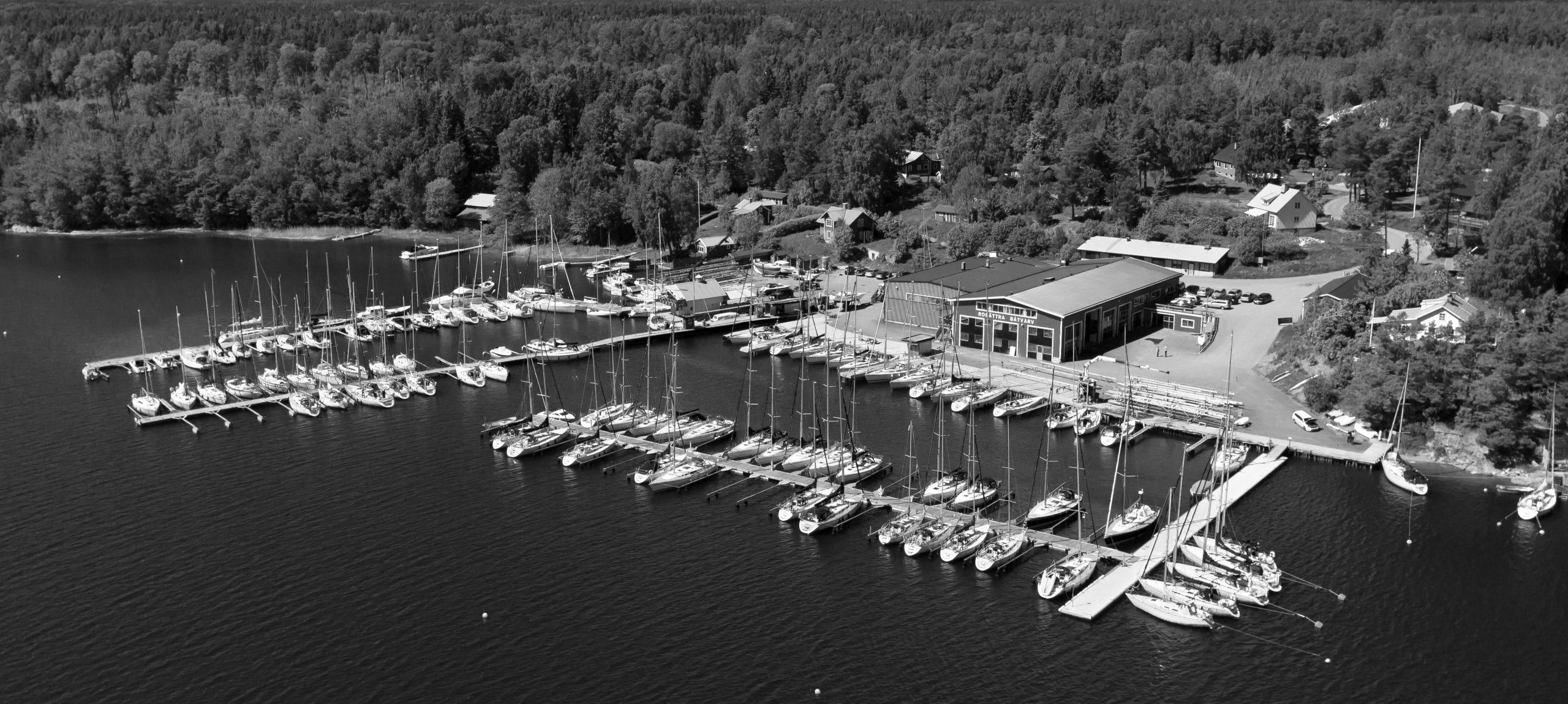
Quality Requires Control
Building and maintaining quality requires detail and control, therefore Rosättra Boatyard manages and produces everything in-house including development, design, plastic work, carpentry, production, sales and service. Rosättra’s great inhouse craftsmanship is symbol of the yard’s heritage and brand value, which is why we carefully select our mahogany stock to ensure a stunning natural pattern and finish, while also allowing every boat to be personalised and bespoke to each client’s needs and wishes.
We are also at the forefront of rapid technological developments, which require new knowledge and skills in order to maintain a high level of boatbuilding. The success of our retractable keel on the Linjett 43 is a great example of Rosättra’s forefront ongoing tech development and attention to details.
"At Rosättra you do not discuss with the customer, you reflect with them.
That is how I got exactly the boat I wanted."
A new Linjett 37 owner

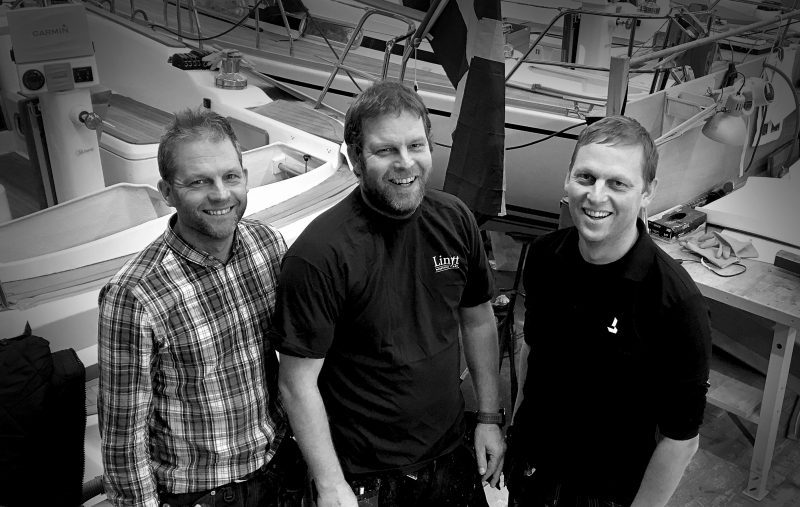
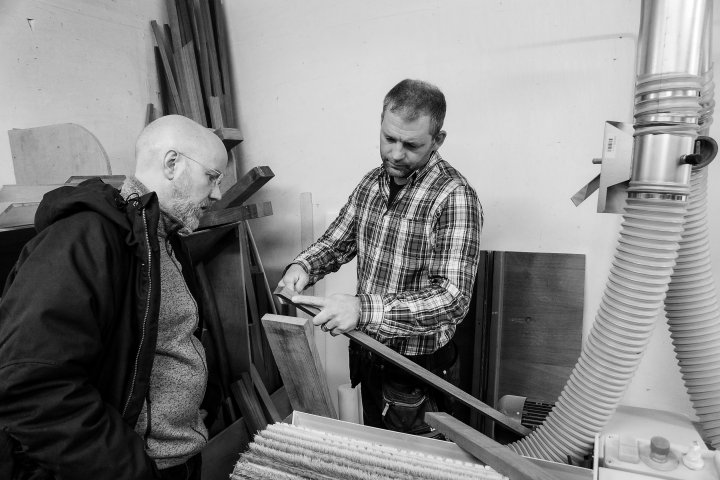
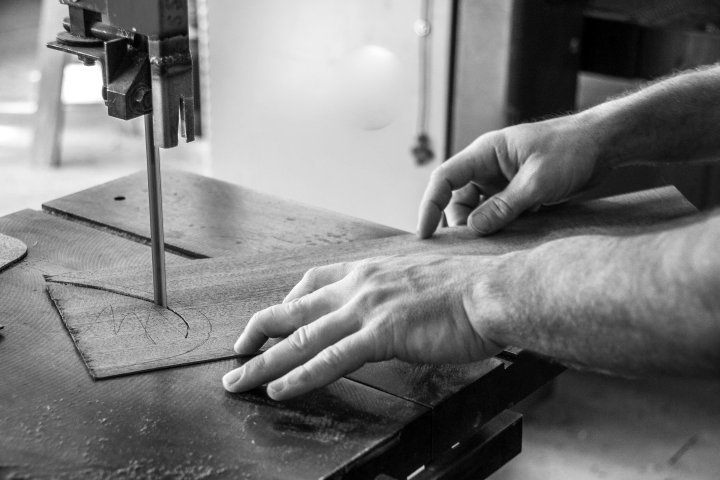
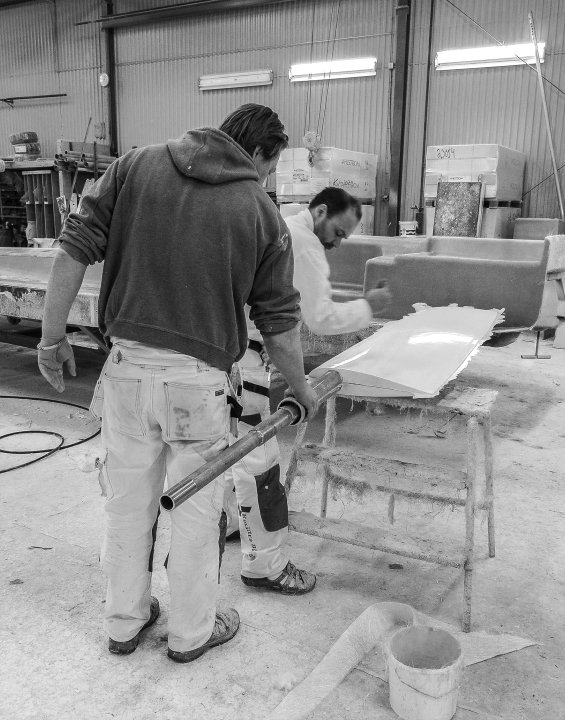
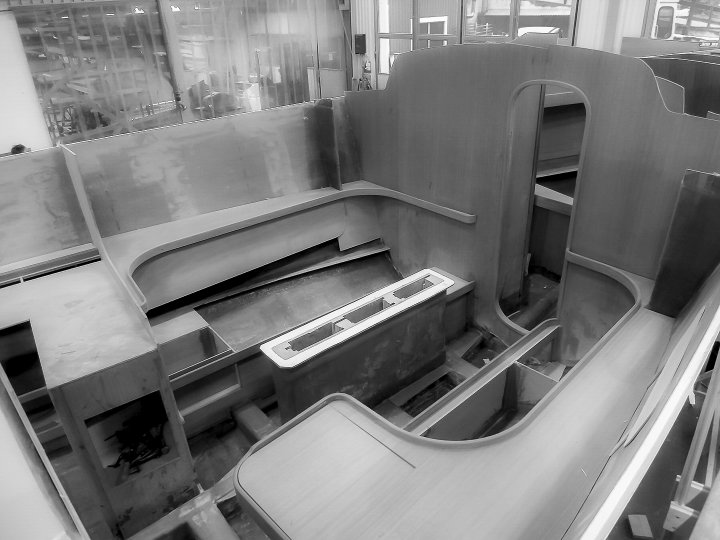
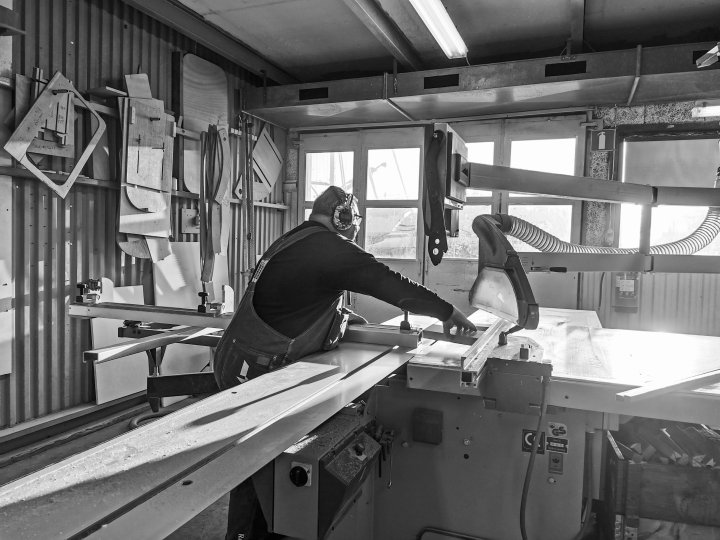
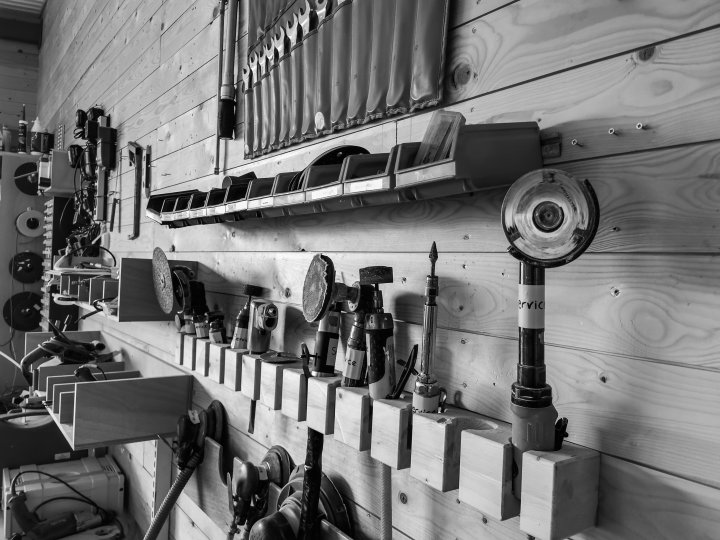
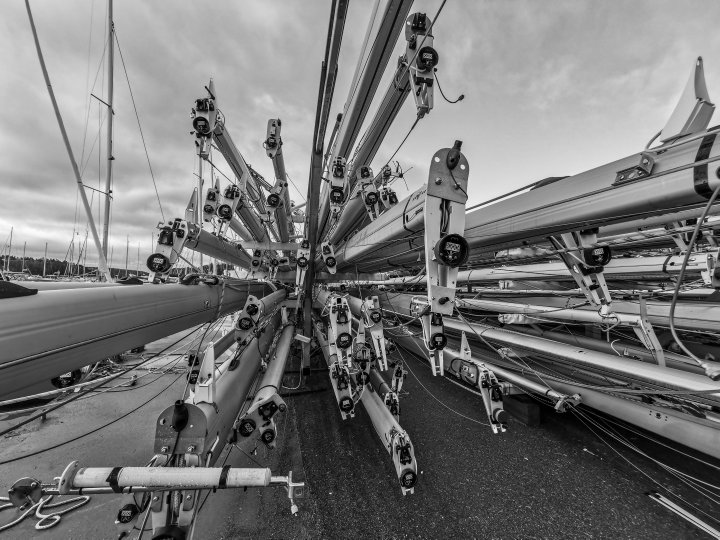
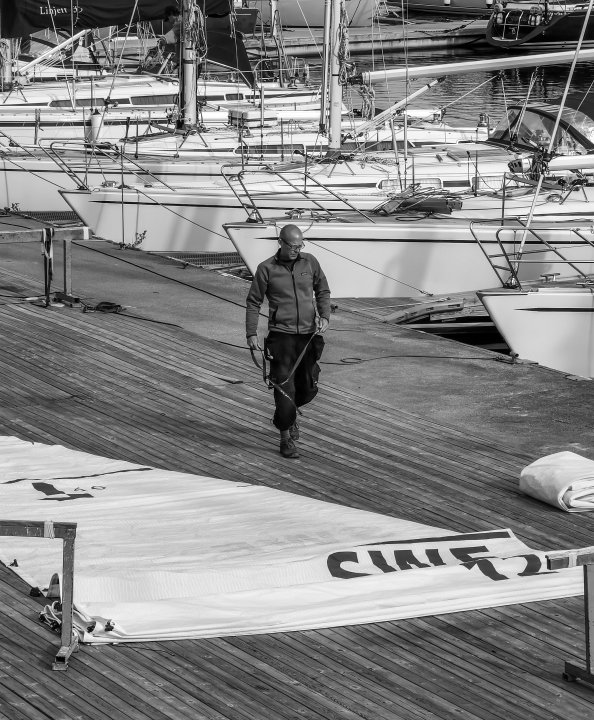
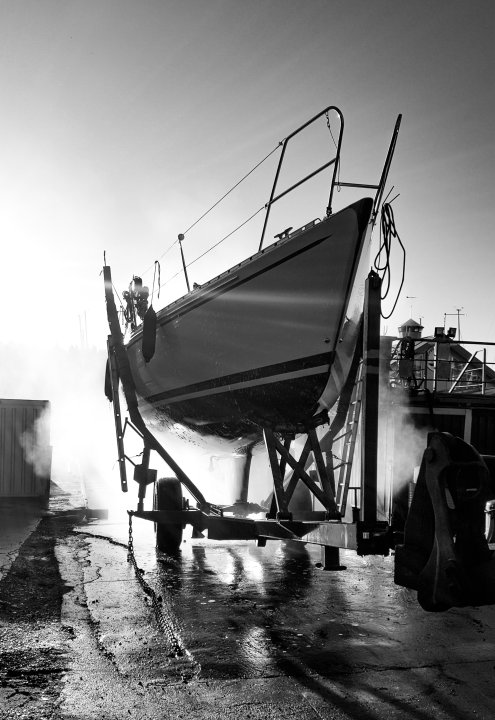
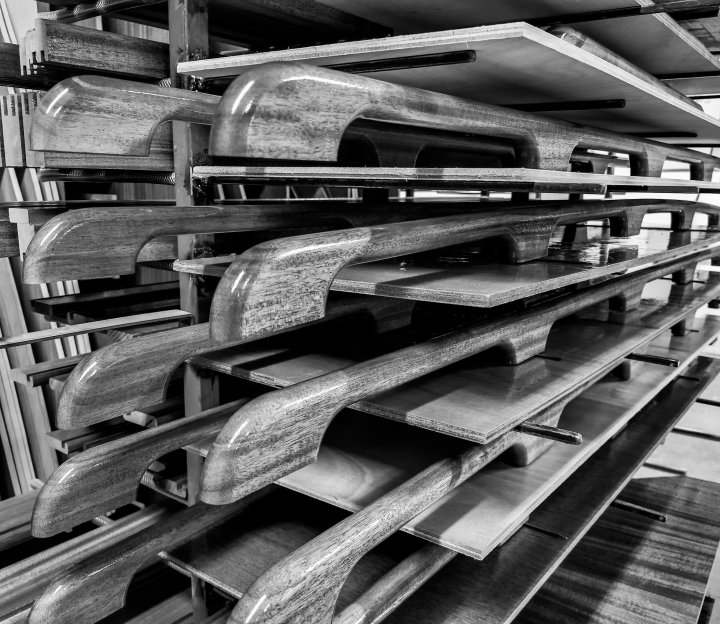
A Family Business Since 1886
Since Rosättra Boatyard started in 1886, only two families in five generations have been owners: Jansson and Gustafsson. Common to both families has been their enthusiasm for innovation and ability to capture the spirit of the times. When people first started sailing for pleasure at the end of the 19th Century, the Rosättra boatyard was already building boats suitable for sailing in the archipelago. And so this ability to predict and encapsulate the trends and needs of their clients has continued throughout the generations.
And thanks to the ongoing commitment to quality, history of craftsmanship and an eye on the future and modern innovation, this has meant the boatyard has continued to adapt and grow to ever changing demands while daring to believe in their ideas and set the trends for modern sailing in the archipelago.
Linjett's History Timeline
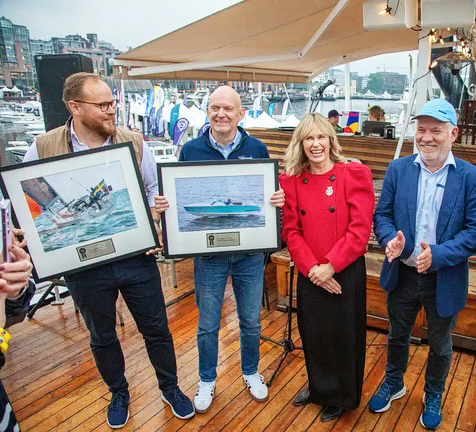
Sailboat of the Year - Norway
Linjett 39 wins the Norwegian Prize ”Årets Seilbåt” with the motivation: The boatyard builds boats to last. They have complete knowledge of every single yacht they have produced, and many of them are looked after by the yard every winter. The sailboat wins neither on price nor volume, but on quality and well-thought-out solutions. The 39-footer is a cruising sailboat that sails so well that it doesn’t take much wind for the sail to be chosen over the engine.
“Boat of the Year” in Norway is established by Båtmagasinet and Seilmagasinet together with a jury member from the Norwegian Boat Federation, Marit Strømøy and a readers vote.
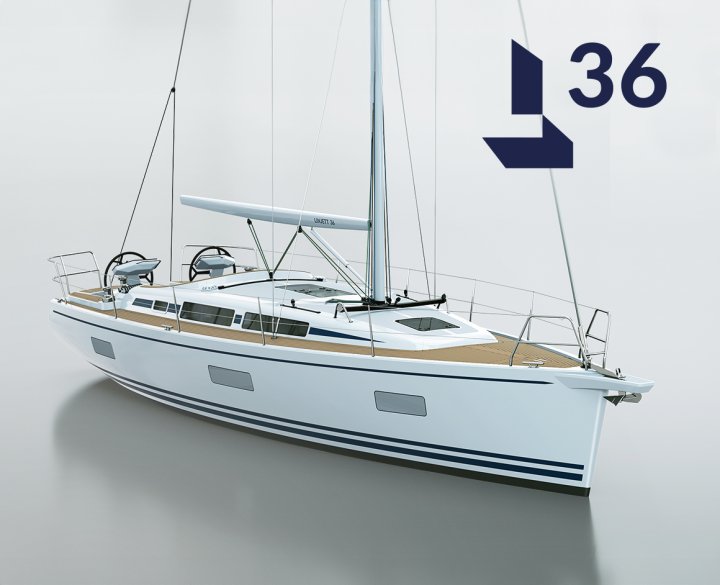
New model – Linjett 36
The news about the tenth model from Linjett Yachts was released in spring 2024. It will be a 36ft yacht with a focus on the joy of sailing and luxurious comfort. The yacht will be the first from Linjett with a fixed bowsprit, to simplify fast and fun sailing with asymmetric spinnakers and code sails. The interior of the L36 has with two cabins, to give space for good interior functions and well-sized stowage spaces. The idea is that the Linjett 36 combines the comfort and equipment level of a larger yacht, with the agility of a smaller boat. The model will be test sailed in 2025, and the first boats will be delivered in 2026.

Linjett-Certified Service Partners
Linjett begins to cooperate with external boatyards to enable easy boat ownership even for those who are not close to the Linjett Boatyard. Linjett carefully selects which yards become Certified Service Partners, yards that Linjett is confident have the same values regarding quality, accuracy and knowledge.
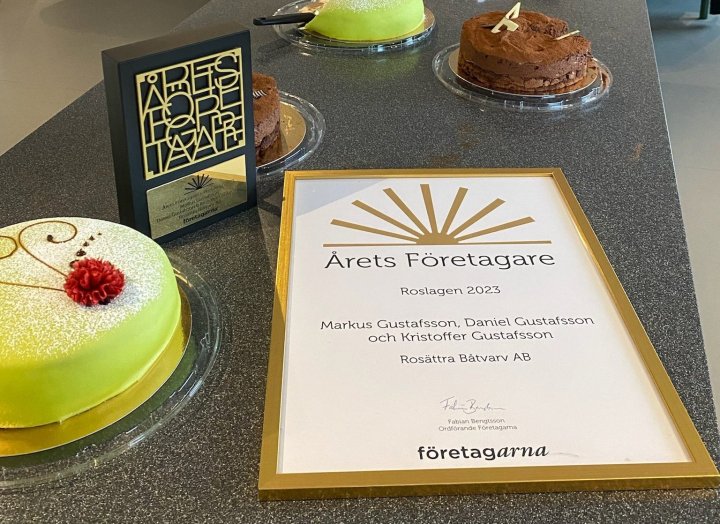
Entrepreneur of the Year
In December, Linjett Yachts is honoured to be named Entrepreneur of the Year in Roslagen by the organization Företagarna. “The award is well deserved after many years of success. Linjett enables many people to experience nature in an exceptionally well sailing boat built with a unique level of craftsmanship. Their products are in the premium segment, and the company has reached the next level winning international accolades,” read the motivation from the jury.
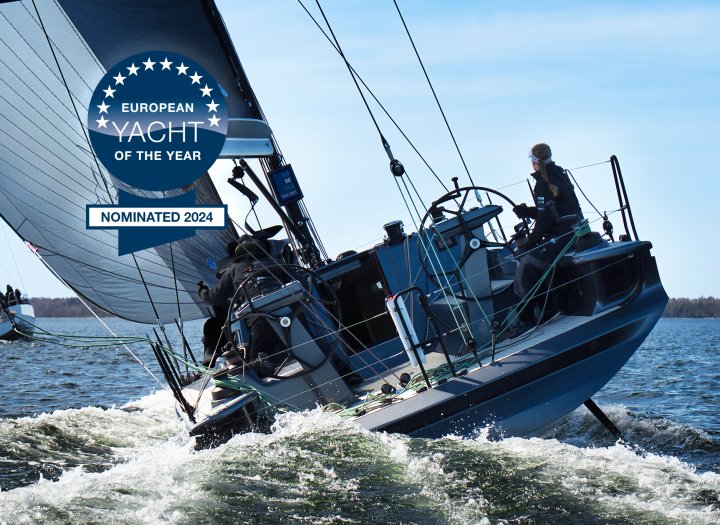
Shogun 43 nominated for the European Yacht of the Year Award
In September, we receive the news of Shogun 43 being nominated for European Yacht of the Year 2024. It is fantastic news for such a young brand as Shogun Yachts and a fine acknowledgment of the work that has gone into developing the yacht model. According to the jury, it was an incredibly strong year with over fifty new launches of exciting models. The Shogun 43 was one of 20 models selected.
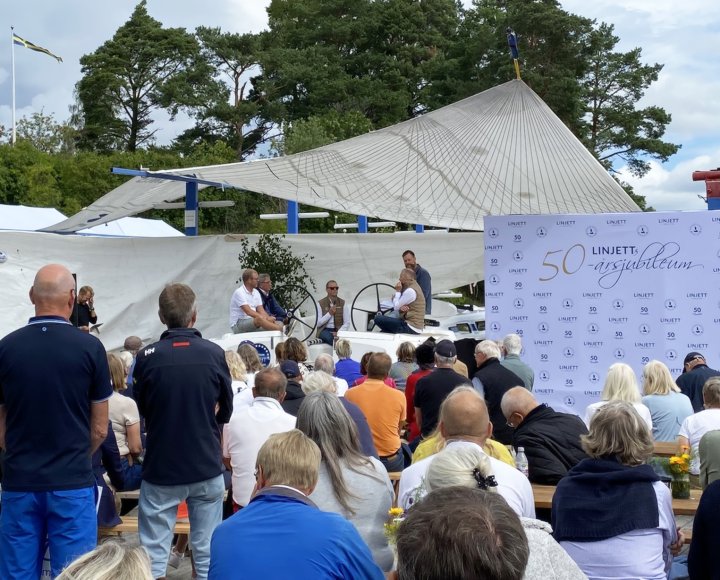
Linjett Celebrates 50 years
During three days in August we celebrated that the Linjett brand turned 50 years in 2023. The festivities were commenced with a proper 50th birthday party for all employees on the first day. On the second day we opened the boatyard to the public, presenting a range of activities, including a grand stage show hosted by Swedish comedian Kristoffer Appelquist. At the dock, all Linjett models ever built since 1973 were on show. The third day was held in cooperation by Linjettförbundet (the Linjett Owners’ Association) to arrange the annual Linjett Championship, followed by Linjett’s traditional Swedish crayfish party in the evening.
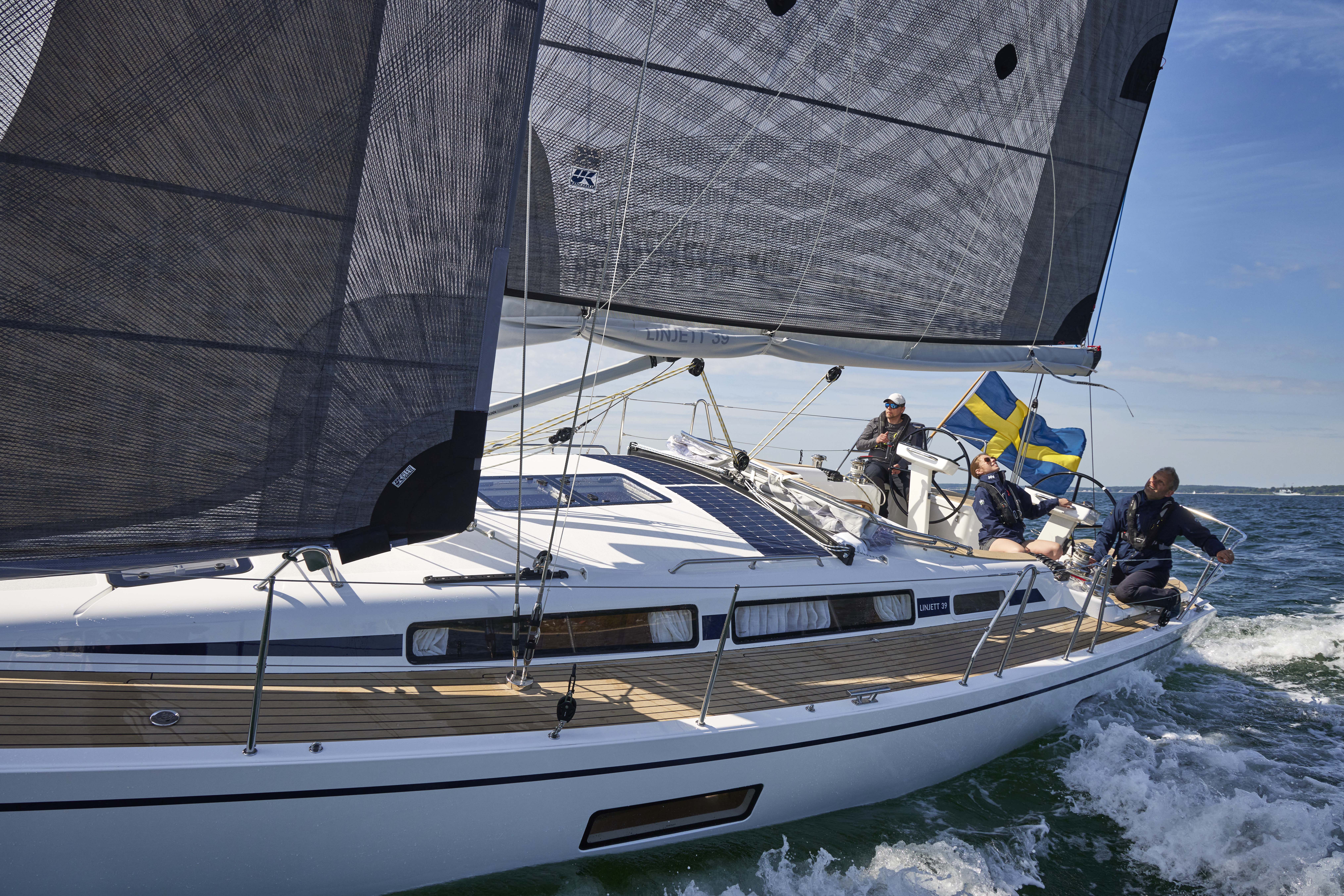
Linjett 39 becomes a success
Just over a year after the launch, the 10th Linjett 39 is delivered to her owners in early summer. The new model to the Linjett range, which has been praised by journalists and industry people alike, is a commercial success and the team at the boatyard must work hard to meet demand.
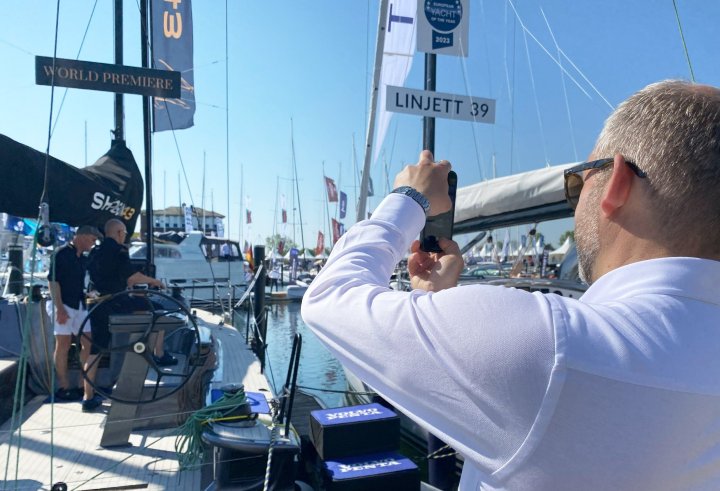
World Premiere of Shogun 43
In May, during the Ancora Yachtfestival in Neustadt, Germany, the Shogun 43 has world premiere and is officially shown for the first time. The boat show offers beautiful sunny weather, smiling visitors and a huge interest in the Shogun 43 – which with her daring and groundbreaking design stands out amongst the rest of the yachts. Many praise the yacht, especially for the high level of detailed interior and the multiple innovative solutions.
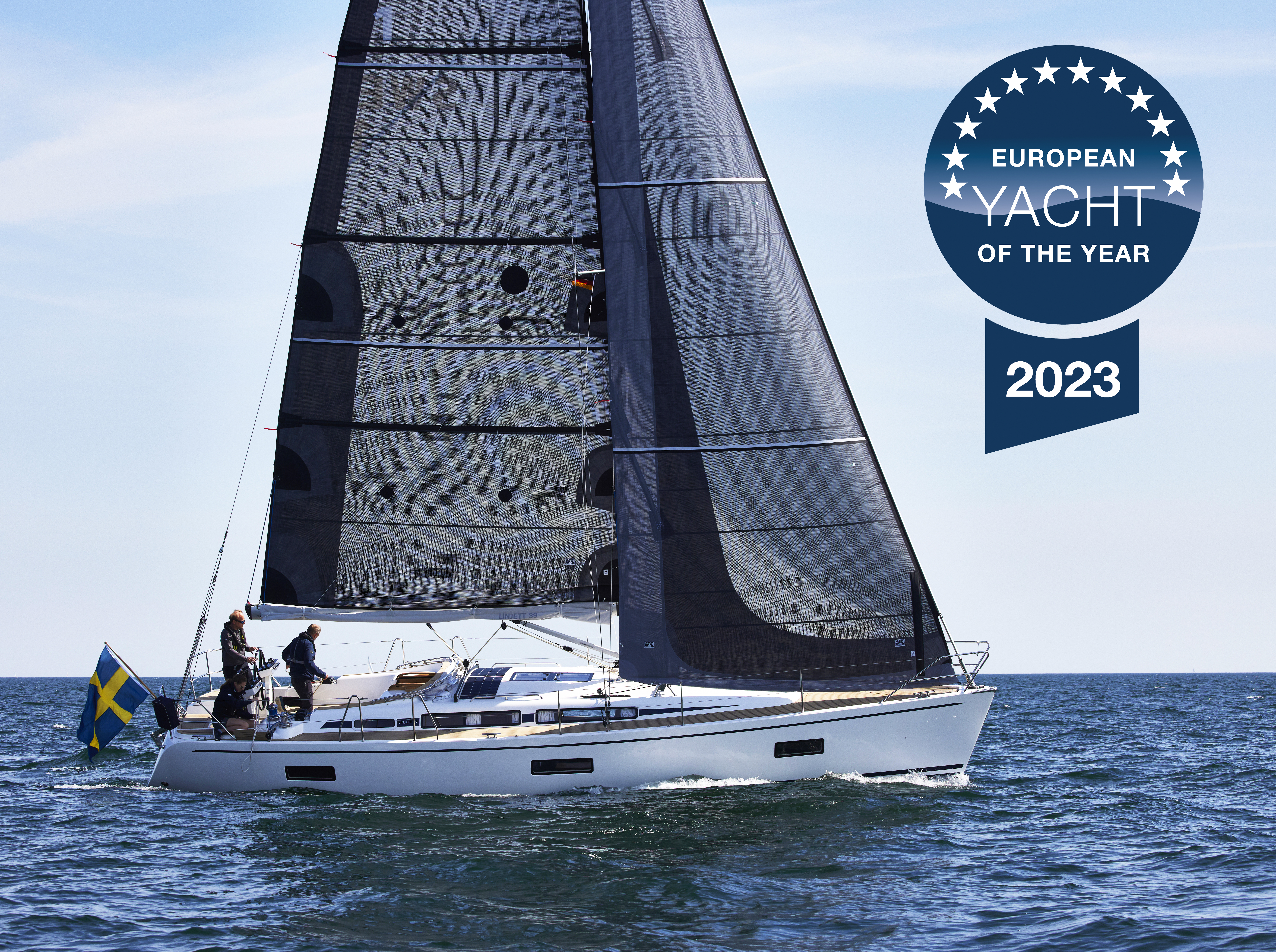
Linjett 39 Wins European Yacht of the Year 2023!
In conjunction with the boat show boot Düsseldorf, held in January, the winners of one of the most prestigious yachting awards, European Yacht of the Year, are announced. In 2023 Linjett 39 wins the prize in the category “Family Cruiser”. A frequently occurring theme amongst the 12 judges’ assessment of the yacht is regarding the craftsmanship, the luxurious feel onboard and how thought through the solutions were. They also praised her sailing abilities and noted how nimble the yacht felt at the helm.
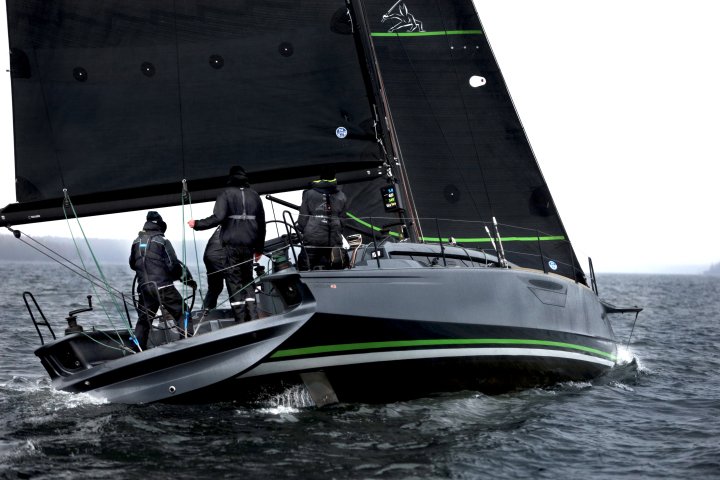
First Shogun 43 launched for test sailing
In November, the first Shogun 43 is launched in classic Swedish autumn weather and test sailed by Linjett. The yacht puts on a show of good boat speed and sailing abilities. Linjett feels satisfied with her performance. After a few things got added to on the upgrade list, the Shogun 43-01 is then again taken up for the build to finish during the winter.
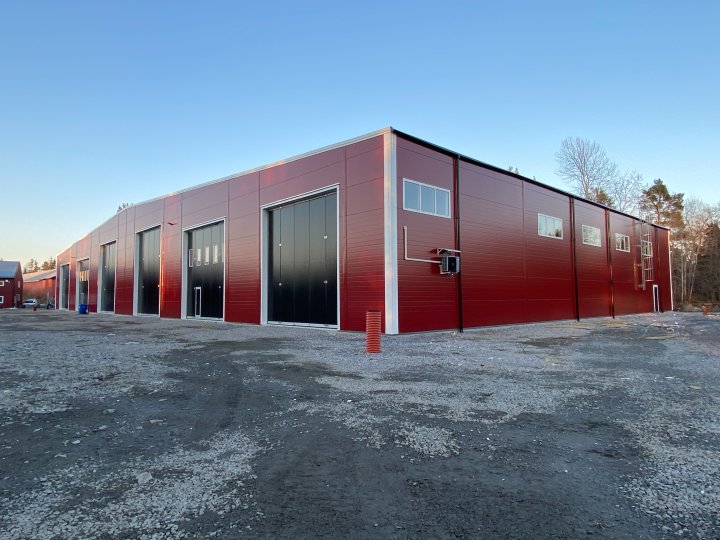
Heated Storage Hall Completed
With the aim to provide our clients even easier ownership we started the build of a 2500 square meter heated winter storage hall in the fall of 2021. Construction is completed in October 2022, just in time for the upcoming winter season. The demand for storage was high and a majority of the spots was filled already during the inaugural season.
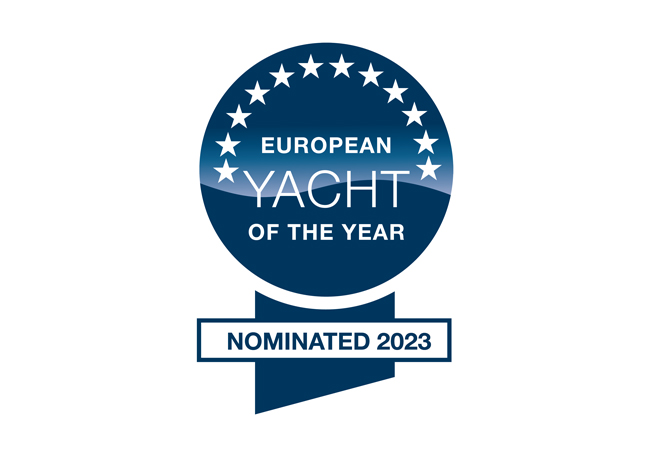
Linjett 39 is nominated for European Yacht of the Year!
In september 2022 is Linjett reached by the exciting news that the Linjett 39 has been nominated for the prestigious price European Yacht of the Year in the category “Family Cruiser”. This means that the yacht has to be sailed to La Rochelle to partake in the official test sailing and an intense planning phase commences. Read more about the delivery adventure to La Rochelle here!
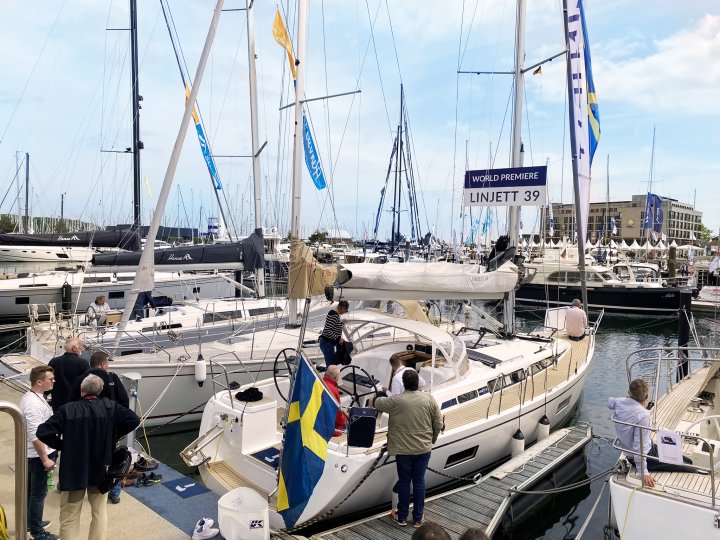
World Premiere for Linjett 39
May 20-22, Linjett were at the Ancora Yacht Festival in Neustadt, Germany, for the world premiere of the Linjett 39! The model became a great success at the show, both visitors and journalists loved the boat. Even exhibitors came onboard, because the talk had started going around at the show, that our Linjett 39 was a must-see. This was also the first time that Linjett was showing a model in a country outside of Scandinavia.
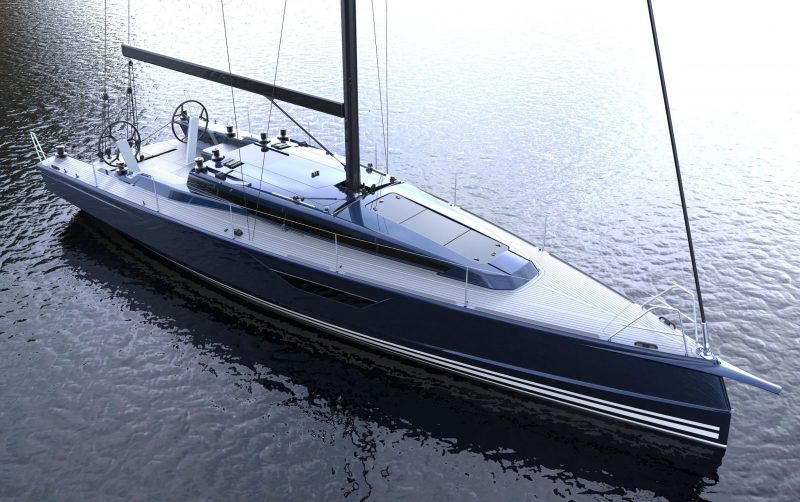
The Shogun 43 into Production
Year 2021 begins excitingly at the yard with the lamination of hull and deck for the Shogun 43, in collaboration with Vaxholm Komposit. The Shogun 43 is the second model for the new brand Shogun Yachts and when the renderings were released in early April, it received global attention. The Shogun 43 has incorporated innovative solutions and is built entirely in carbon for maximum performance. The model is scheduled to be launch in the autumn of 2021. For more information, visit shogunyachts.com.
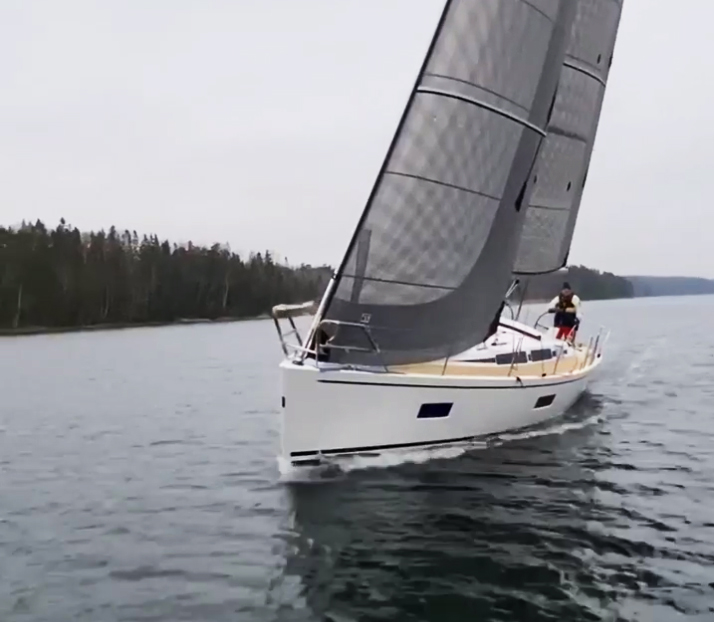
First Sail with the Linjett 39
Just before Christmas, the first yacht of the new model Linjett 39 was launched and sailed for evaluation. Only the hull and deck were ready at the time and except the engine, there was no interior inside the boat. She was rigged for one week of test sailing with altering winds and sea state, before she was taken up again to continue production. The result was superb, the boat’s stiffness – even without interior and bulkheads – proved to be very strong thanks to the new bottom structure. Linjett were also pleased with the sailing abilities. By this time, three more boats of Linjett 39 were already planned for production and the first ones will sail to the summer of 2021.
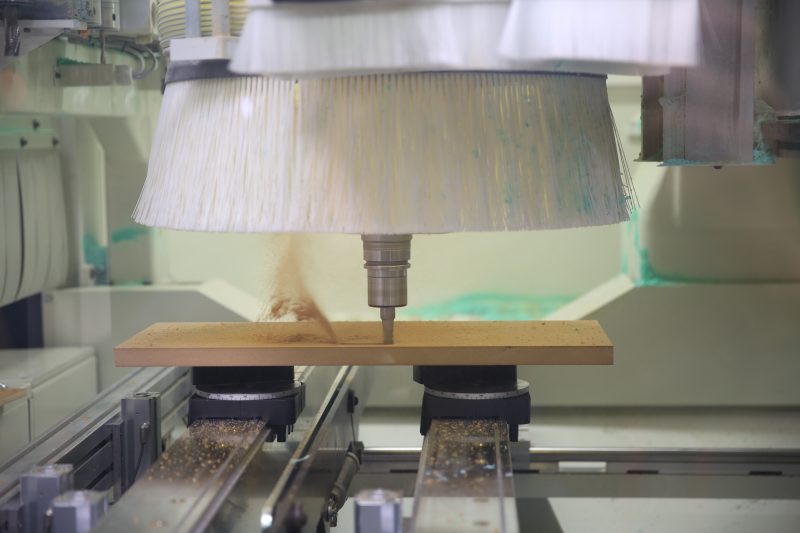
New CNC Milling Machine
It is busy times at Linjett and the production is totally full during the autumn of 2020! To modernize and streamline production, a completely new CNC milling machine with a 5-axis cutter is installed at the Linjett Yard. The new CNC milling machine increases production efficiency and contributes to a higher quality in the build of the yachts.
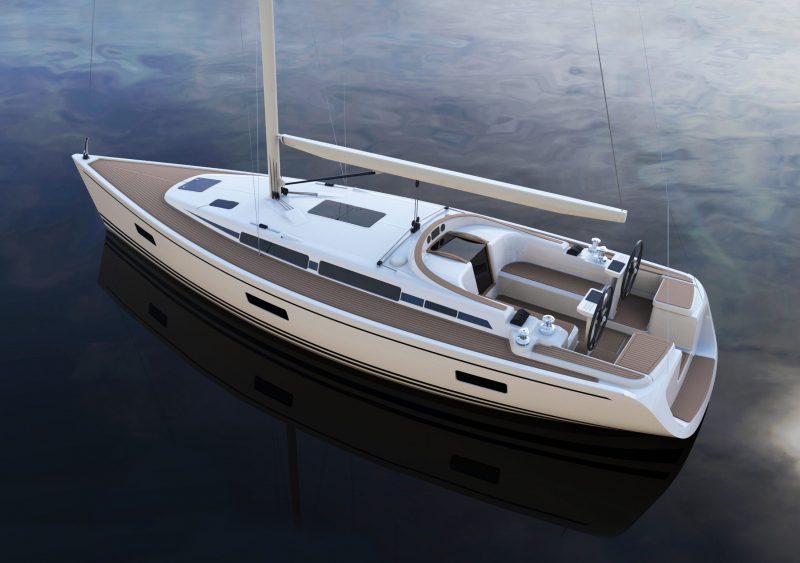
The Linjett 39 is Presented
Linjett Yachts exhibits at the boat show Allt för Sjön in Stockholm during March 2020, where the new model, the Linjett 39, is presented to the public for the first time. Due to the breakout of the Covid-19, the boat show is forced to close down only after five days, but the interest in the new model had still already shown to be large. The Linjett 39 is the first model presented from Linjett where the design is a collaboration between their traditional yacht designer Mats Gustafsson and the young, upcoming designer Oscar Södergren.
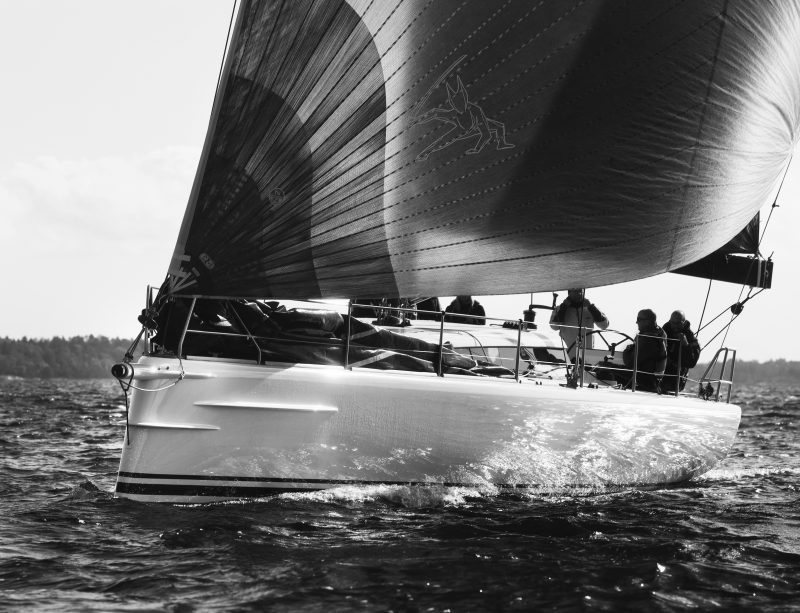
Victory
During the ORCi European Championships in Oxelösund, the new Shogun 50 (Ladykiller4) wins its first race by taking victory in the sprint race of the week. After making its regatta debut at the Swedish Nationals in Sandhamn in August 2019, the new model shows great ability to continue to perform in both national and international racing.
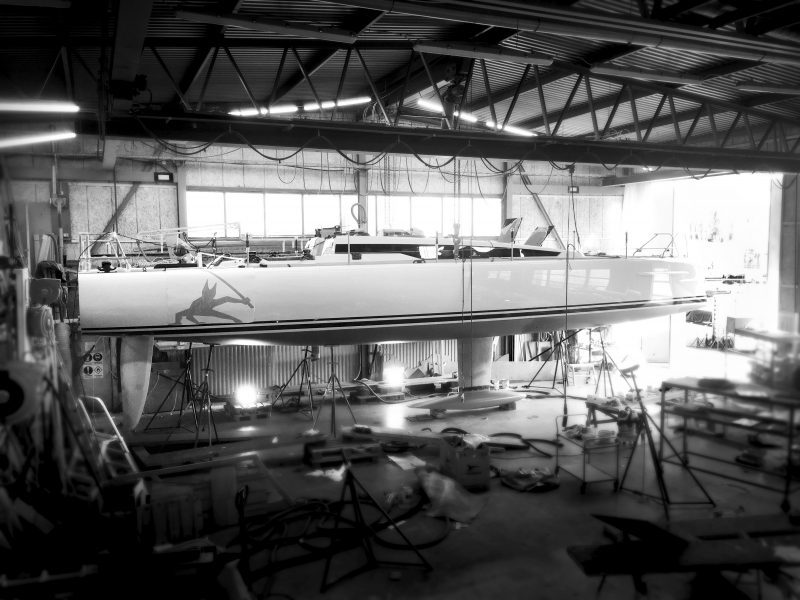
The Shogun 50
In 2019, Rosättra was commissioned to build the new model Shogun 50 – a new and modern yacht design by Håkan and Oscar Södergren. The 50-footer is built for 100% performance and 100% comfort, all in carbon fibre with plenty of attitude. The hull is vacuum infused, and the keel can be retracted 1.5m into the boat with hydraulics.
There were several unique challenges to overcome during the build process, and close collaboration between boat carpenters, project management and designers was essential in completing this successful project.
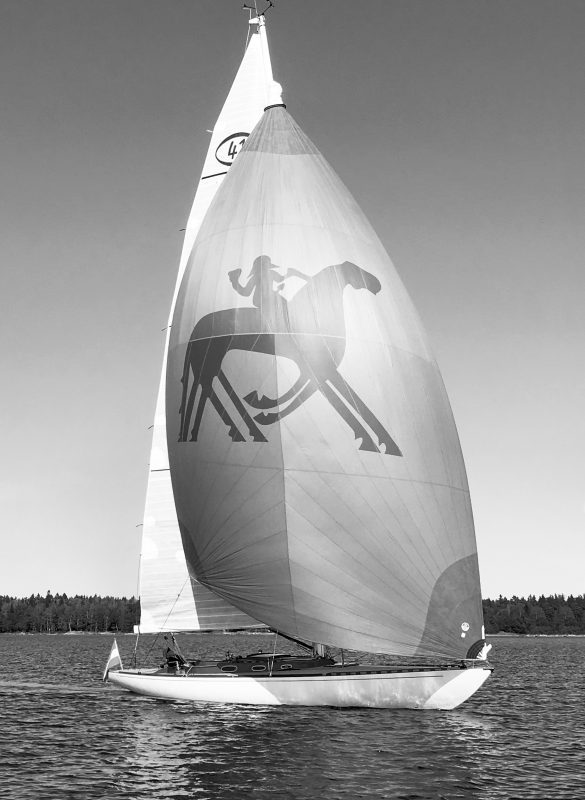
The Swede 41
Rosättra’s reputation for detail and quality has always bought continuous attention and new orders.
However, when the order for the Swede 41 arrived in 2018 it had been almost 50 years since the boatyard had done any special projects, having been busy with their own line production. This was the first custom-designed project that the yard had taken on since the late 1960s and the order initiated a collaboration with Classic Swedish Yachts, with both companies sharing an interest in long-term customer relationships, individually built sailboats and a commitment to quality.
Long lasting and friendly relations with the customers have, combined with their high-quality yachts, built Rosättra’s reputation. It is here, the absolute feeling of quality and the close relation to the customer, where Classic Swedish Yachts and Rosättra found one another.
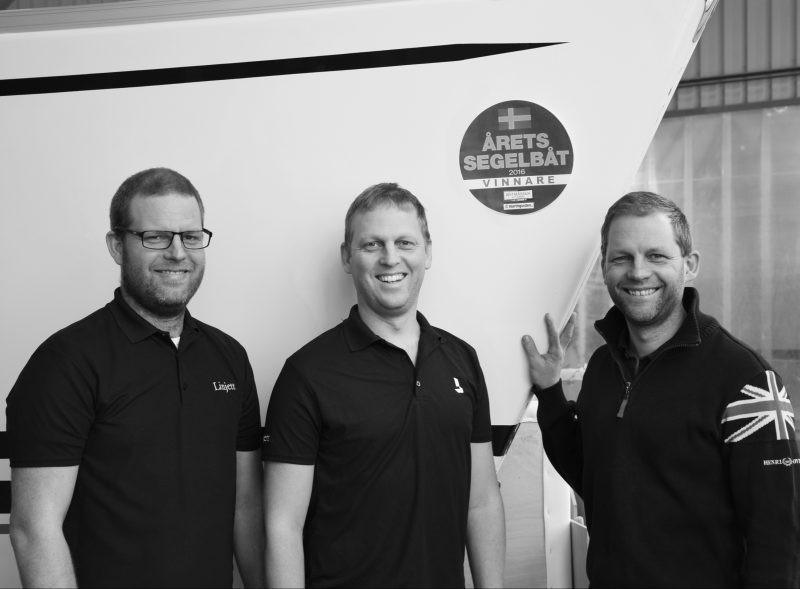
Linjett 43 Awarded "Sailboat of the Year"
The boatyard’s largest and most advanced design – the Linjett 43 – is announced as “Sailboat of the Year” in the offshore cruiser class, confirming the winning Linjett philosophy of building beautiful sailboats designed to sail safely through all weathers and conditions.
“Spacious for its 43ft, modern style, clever interiors, good sailing abilities and above all, equipped with a retractable keel which can withstand a grounding in pacing speed. The new Linjett 43 is the most interesting and innovative cruiser yacht this year and a great example of what small and skilled Swedish yards are capable of.”
– The Gothenburg Boat Show & Marine Guide
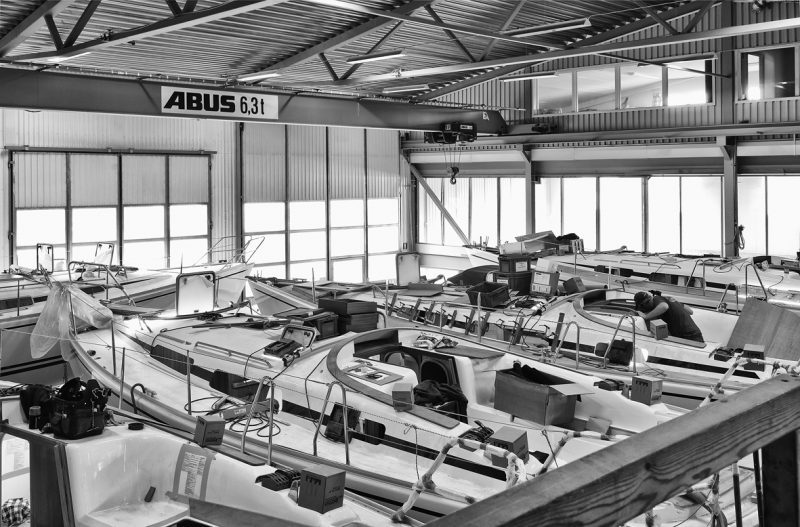
New Service Hall Opens
Winter storage and service is becoming more popular and important as owners increasingly request help with maintenance and repairs. In response, the new and much-anticipated service hall opens in 2012, which is connected to the winter-hangars that store over 200 Linjett yachts.
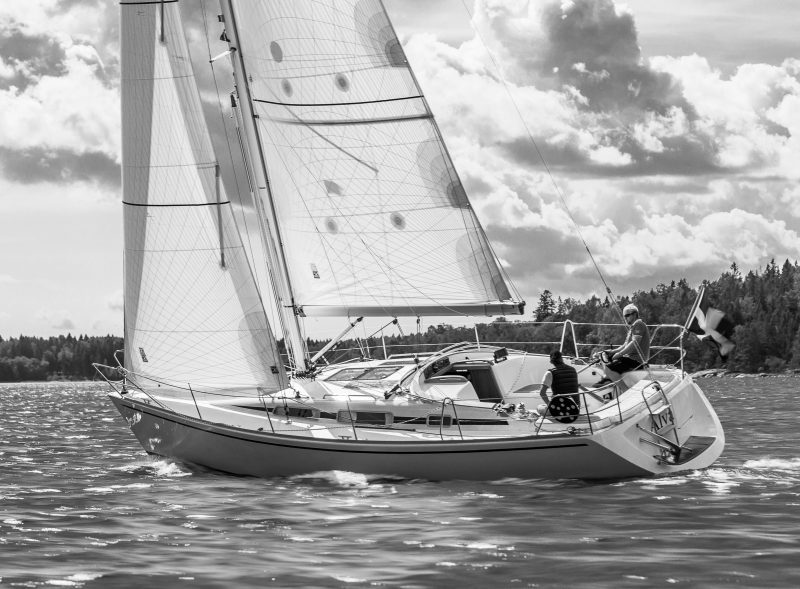
Linjett 34
The new Linjett 34 replaces the popular Linjett 33 and becomes the first Linjett with an openable stern. A clever design that creates a more spacious cockpit and easier access from the stern, the concept was designed by Mats Gustafsson in collaboration with his son Markus, who was involved in the construction. The trend in the yachting industry continues towards wider sterns, therefore the Linjett 34 is wider than its predecessor, which benefits the cockpit area, as well as the increased room in the saloon and stern cabins. The higher freeboard and increase of natural light into the boat also boosts the volume.
The Linjett 34 carries more sail area relatively to the sister models, Linjett 37 and Linjett 40. The first Linjett 34 went to Finland, which is one of Rosättra’s largest export markets.
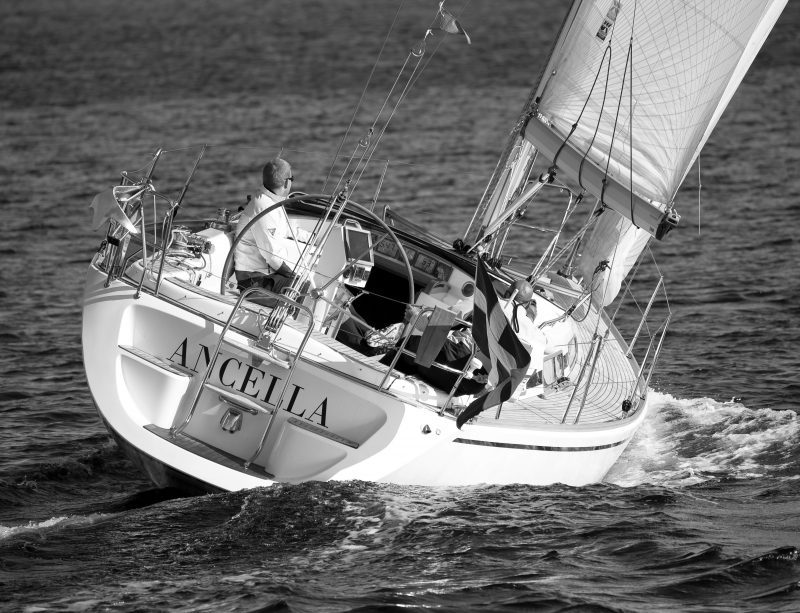
Linjett 37
In 2007, the Linjett 37 replaced the Linjett 35 and became a follow-up to Linjett 40 – setting the tone for the modern models that are still being built today.
Upholding Rosättra’s mission to release a new model every five years, the Linjett 37 was designed to be sailed double-handed and introduced hiding the lines under the deck from the mast directly to the winches. The keel was developed to easily distribute the force during a grounding and thus minimise damage, and the stern is widened to accommodate two aft berths for large families or guests on board.
The Linjett 37 became a successful family boat with particularly good sailing performance. A well-balanced thoroughbred.
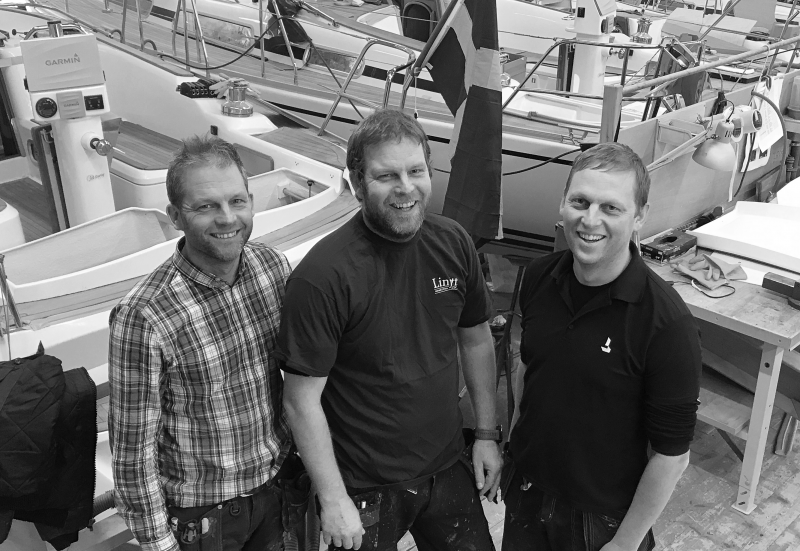
Third Generation Gustafsson
The boatyard’s owner, Mats Gustafsson steps down as CEO and hands over responsibility to his son Markus – the third generation of Gustafssons to lead the boatyard’s management. Markus’s two older brothers also get involved. Kristoffer takes on responsibility for purchases, inventory and support – with a three-year education in electronics, he is the natural expert for the growing demand of electronic equipment. And finally Daniel, the eldest of the three, returns to Rosättra to take over the management for marketing and project management after 10 years as a data consultant and logistic manager in Stockholm.
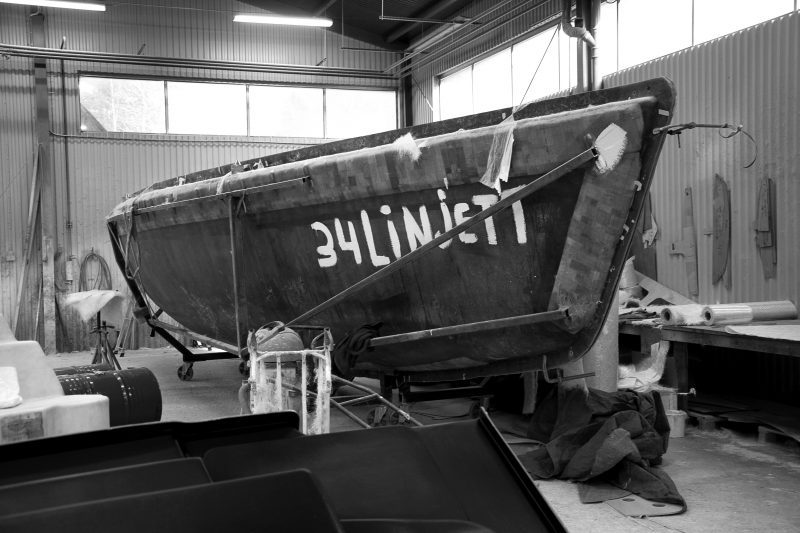
In-House Laminate Workshop
The boatyard brings the production of plastic and fiberglass hulls and decks in-house, having previously been manufactured by a subcontractor. In building close to the yard, a team of five do all the plastic work onsite creating the hulls from fiberglass and casting in moulds of two halves, they are then laminated together. The deck is infused in its own mould and gets laminated later in the process.

One Yard Becomes Two
Around the Millennium, there was a concern at the boatyard. The three sons of the second generation had seven children in total: could all the cousins take over one yard? The solution was as simple as it was brilliant: two boatyards.
Of the 450 boats in winter storage at Rosättra, two-thirds were brands other than Linjett. One brother, Ola Gustafsson sold his share, while the second brother Jan took care of the business Servicevarvet AB with his two sons Anders and Erik.
Mats Gustafsson continued with Rosättra Båtvarv AB and the production of the Linjett yachts, together with his sons Daniel, Kristoffer and Markus. The solution worked well and both yards continued to grow.
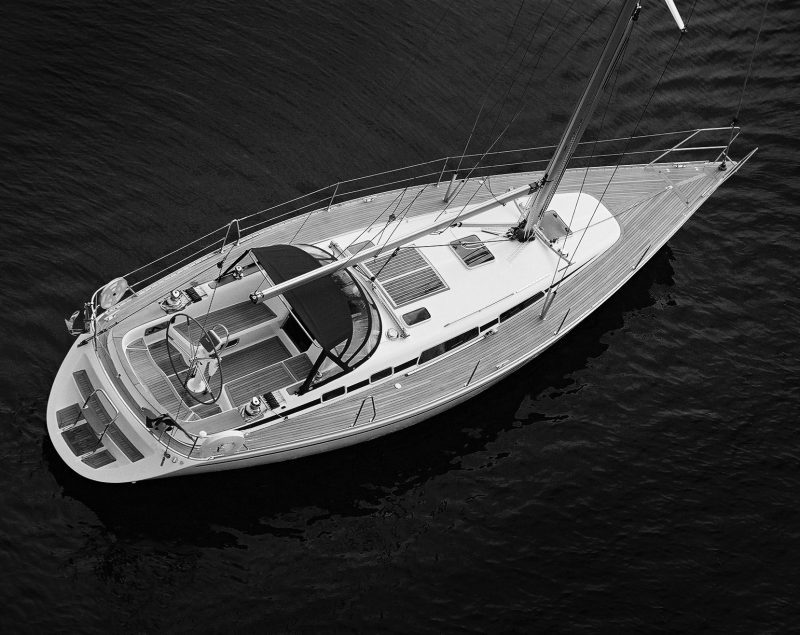
Linjett 40
It was time for Rosättra’s largest boat to date to be introduced: the Linjett 40. After ongoing pressure from customers for a larger model, Mats Gustafsson designed a boat that could be easily sailed in the archipelago and on open water by only two people. The demand for a moderate draft on a larger yacht was solved with a conical shaped keel, with a hint of bulb. For the first time, a Rosättra boat was fitted with a steering wheel as standard. Another welcome detail was the recessed anchor in the bow.
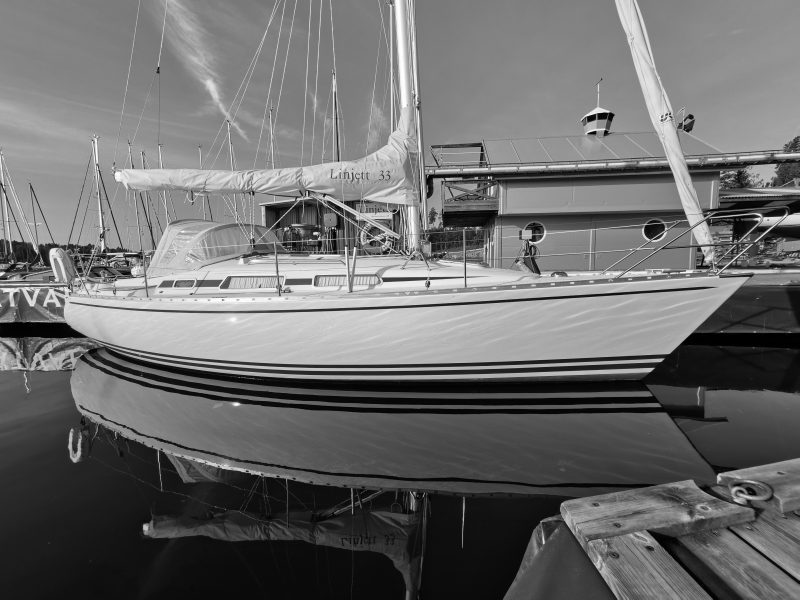
Linjett 33
After almost 15 years, the bestselling Linjett 32 needed a replacement and expectations were high as it was important the new model showed the quality and character of a Linjett.
The Linjett 33 had started development in 1993 in a year where a total of 48 new sailboats were sold in Sweden, with Rosättra accounting for a quarter of them. Customers increased their demands for customised solutions therefore the majority of changes to any new model took place below deck. Structural changes meant the stern became 20 cm wider than the Linjett 32 and the bow slightly straighter. The rig became taller with a larger sail area. The Linjett 33 was produced for 16 years, manufacturing a total of 181 boats.
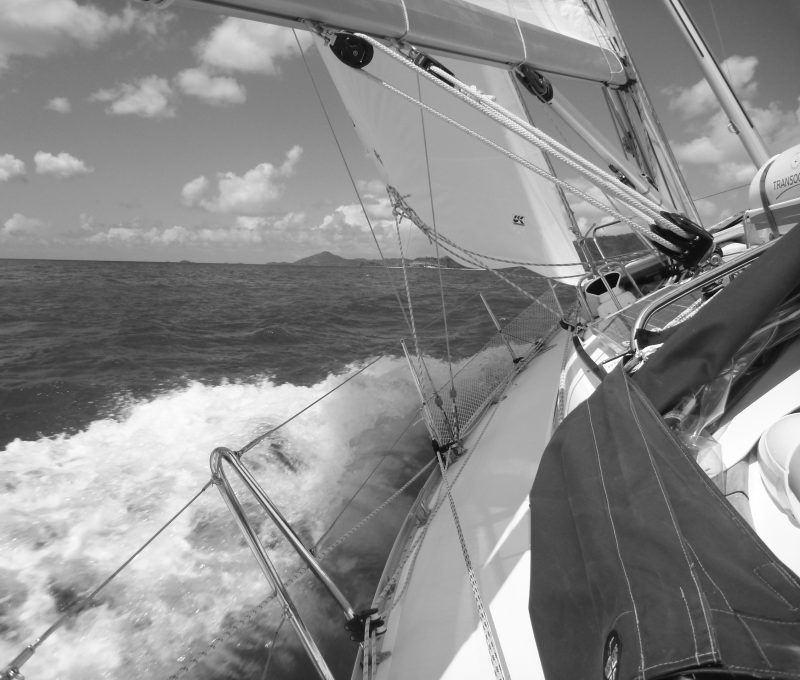
Success in The Gotland Runt Race
The Linjett 35 “Ancilla” won the Gotland Race in both 1990 and 1993 with Mats Gustafsson as Skipper and his sons Daniel, Kristoffer and Markus in the crew. The Linjett 35 went on to have a number of successes in both minor and major races, and in the Gotland Race in 1996, Linjett yachts were placed in first, second, fourth and sixth.
But it was in 1998 that Linjett had a record-breaking year, when Mats won again with the new Linjett 33, and another five Linjett yachts took good places in the top ten. It was during this time that the boatyard had good wind in its sails and came up with the benchmark of making a new model every five years became, which has been withheld since 1989 until today.
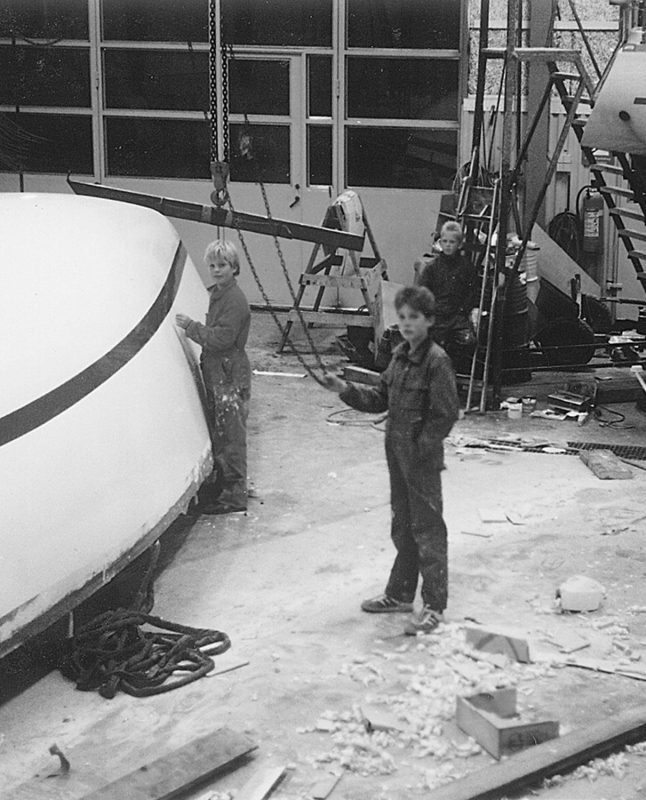
Linjett 35
Daniel, Kristoffer and Markus Gustafsson have been a part of the boatyard since childhood. This photo of them was taken during the construction of the new Linjett 35, which was inaugurated by their grandmother Göta Gustafsson on May 20, 1988.
Instead of building quantity, the yard invested in quality and caught onto the new trend of building larger boats. The Linjett 30-footer which had previously been perceived as large, now began to feel cramped and clients were looking for more space when Mats started designing the Linjett 35.
Initially worked on during his spare time in order to keep costs down, when Mats finally revealed the Linjett 35, it was met with enthusiasm by both customers and staff at the boatyard. After surviving difficult times in the early 1980s, Rosättra was now manufacturing a quarter of Sweden’s new boats, and following the launch of the Linjett 35, Rosättra produced 16-18 boats a year of the models L32 and L35. The Linjett 35 was manufactured for 17 years, producing a total of 102 boats.
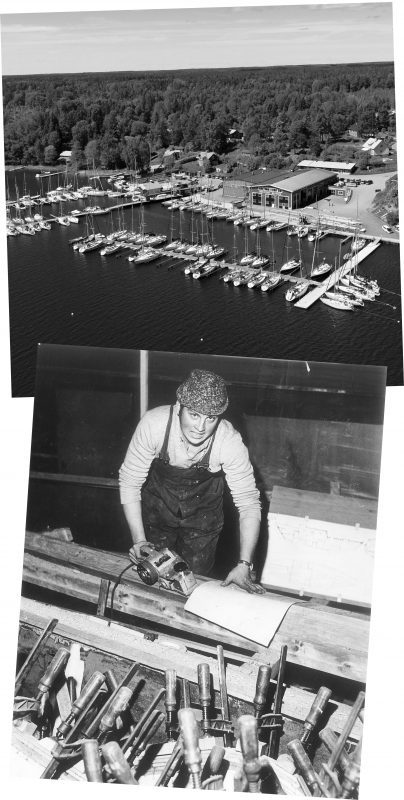
Shipbuilding Crisis in Sweden
At the end of the 1980s came a second crisis for ship building.
The first cracks were seen at the 1976 New Year celebrations at Albin Marin, which was the opening ceremony for its huge new factory in Kristinehamn, boasting a production potential of 2,500 boats a year. Ironically, it opened at the same moment the demand for sailboats reached its peak, and sales began to decline at an alarming rate – even more so when new tax regulations in 1980 meant clients could no longer deduct their interest rates in their tax returns.
Another, more alarming problem came from the many complaints and returns the new generation of boatbuilders were receiving from clients. Underestimating the forces of wind and sea in heavy weather, the complaints of broken boats removed the profits for the new yards. And when the record high inflation of the 1970s came down to a sensible level, it was the final nail in the coffin for the yacht industry. The party was over.
Major companies withdrew from the boat industry with millions in losses. Albin Marin’s grand new production hall was sold for a penny and Sweden’s second giant, Pelle Petterson AB, also went down – only a few exporting boatyards on Sweden’s west coast managed to cope in the crisis.
On the east coast, the Rosättra boatyard was almost a lone survivor, and the only one with a history in wooden boat manufacture. At Rosättra, the production of Linjett 32 carried on unaffected. Thanks to their ongoing strategy of quality over quantity, the yard had not expanded majorly and could uphold its moderate scale production even in the difficult times.
“Things are going well now and we are fully engaged in production,” Jan told Norrtelje Newspaper in 1983.
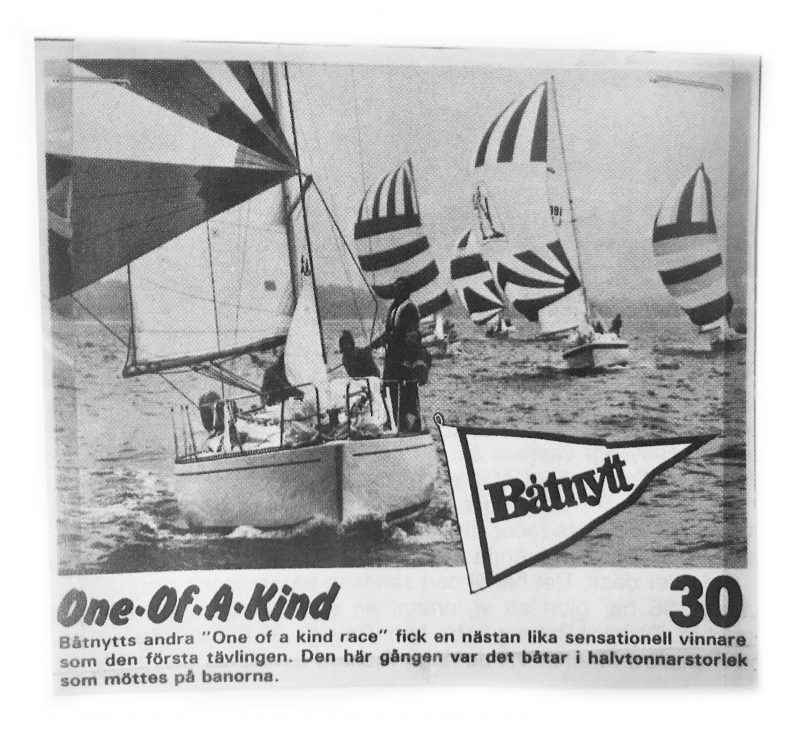
One of a Kind
The magazine Båtnytt‘s One-of-a-Kind Regatta in 1980, was the only official race between different yacht manufacturers where all the models and brands were tested against each other. Everyone in the industry took part, and the boats that sailed well meant a direct impact on sales. It was crucial to get a good place.
So when the Linjett 32 won the Regatta, beating 14 other boat models and manufacturers, it was no surprise that the sales rocketed! Demand for the boat was higher than what Rosättra could meet, even when production was pushed to 25 sailboats per year. The Linjett 32 was produced for 14 years, making a total of 263 boats.
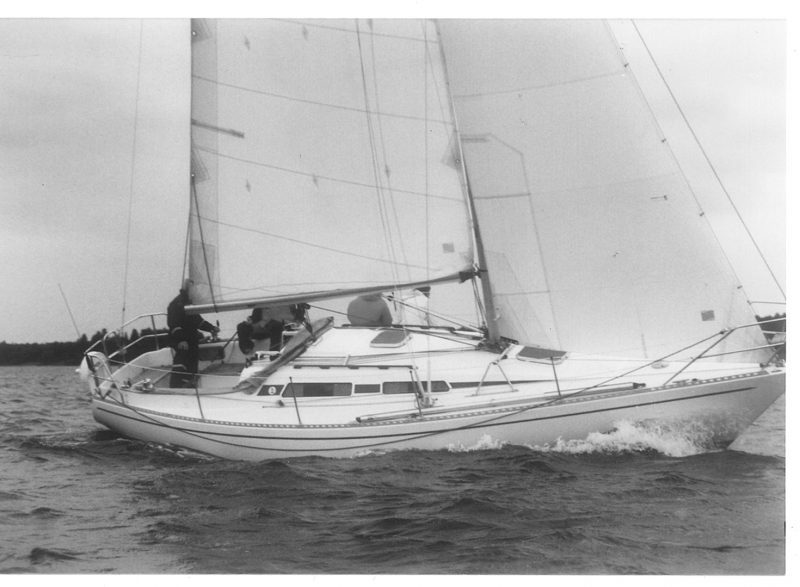
Linjett 32
It was clear from the success of the Linjett 30, that it would need to be replaced by an even better model. And with new international racing rules (IOR) introduced in 1970s, yacht builders now had new requirements to meet, with mathematics and engineering now playing a massive role in production.
Having taken over as designer from his brother Jan, Mats Gustafsson began testing the new Linjett 32 models in the bath before doing the calculations. When he tested the first plug, Mats realised there was too much sail in relation to the waterline, so he cut the plug apart and increased it by 22 centimetres.
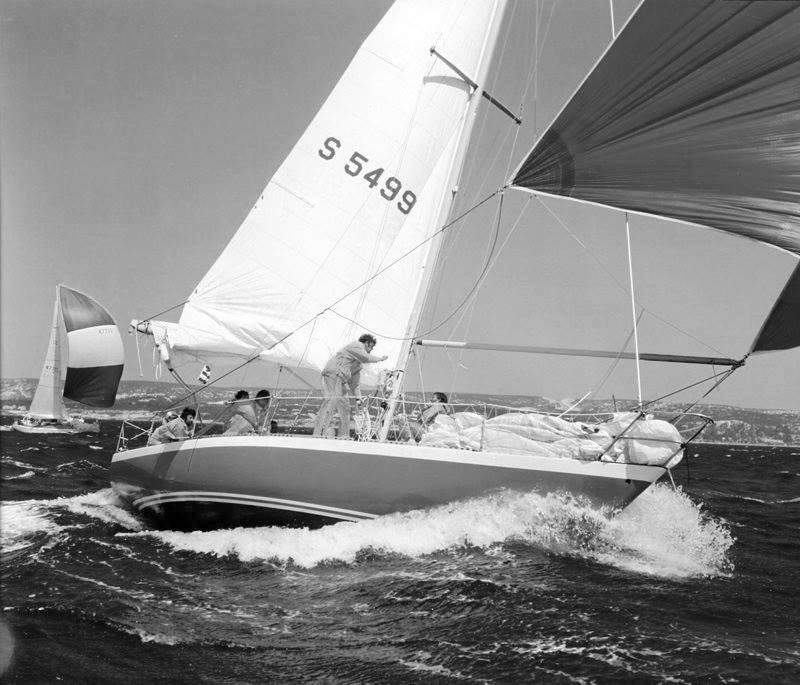
Knock on Wood
This year, the custom-designed order Knock-on-Wood was built. Commissioned by Olle Linger, a successful sail racer who wanted Rosättra to build a boat following the strict specifications of the designer and sailmaker Ted Hood. The boat reflected many innovations and experiments taking place in boat building during this time, including drilling samples out of the composite hull to be tested in America.
When the One-Ton Cup race was sailed in Marseille in 1976, all of sailing’s great designers were there, including Mats Gustafsson. And despite Knock-on-Wood not having great success in the race, the project did share a lot of learnings for the team and the yard.
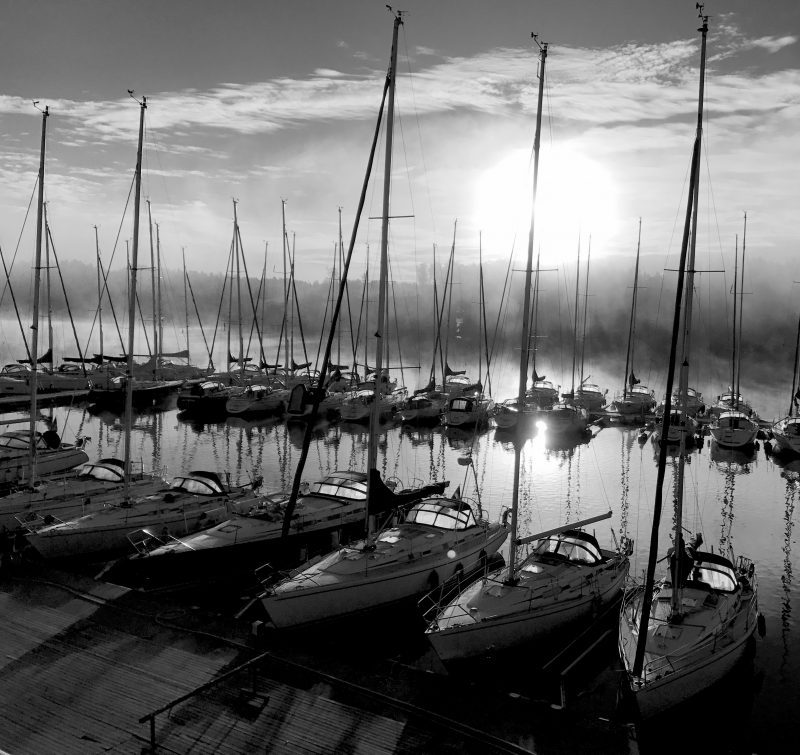
Expansion
In 1977, boat production was increasing and Rosättra expanded its facilities by a few 100sqm, allowing for more offices and warehouse space. Years later, more investment was needed for a new 550sqm production hall, however, to manage the financing Rosättra needed a loan of SEK 400,000.
Banks refused to give the yard a loan and support finally came from a private financier and Linjett owner who saw the value in the Linjett 32 model: “If you don’t survive these times, no other yard will either.” And he was right. Today the Linjett 32 still holds the record for most built of any Linjett model.
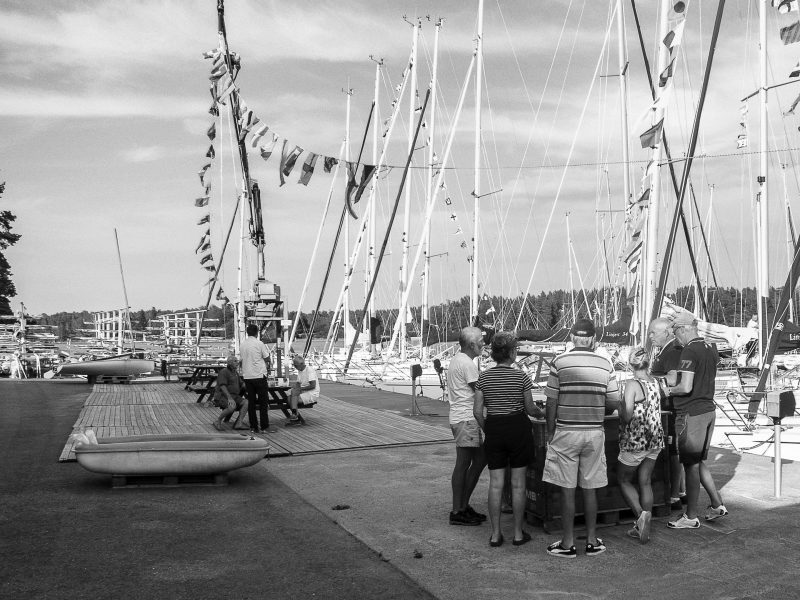
The First Linjett Championship
At the launch of the first Linjett Owners’ Championship, 28 out of a total of 35 boats participated and 45 years later it is still a much-loved tradition that is upheld today, and is seen as the foundation of the Linjett Owners Club that was formed 10 years later.
This ongoing commitment and mutual interest between the yard and boat owners, ensures Linjett yachts are a well-loved and recognised brand.
Read more at Linjett.org.
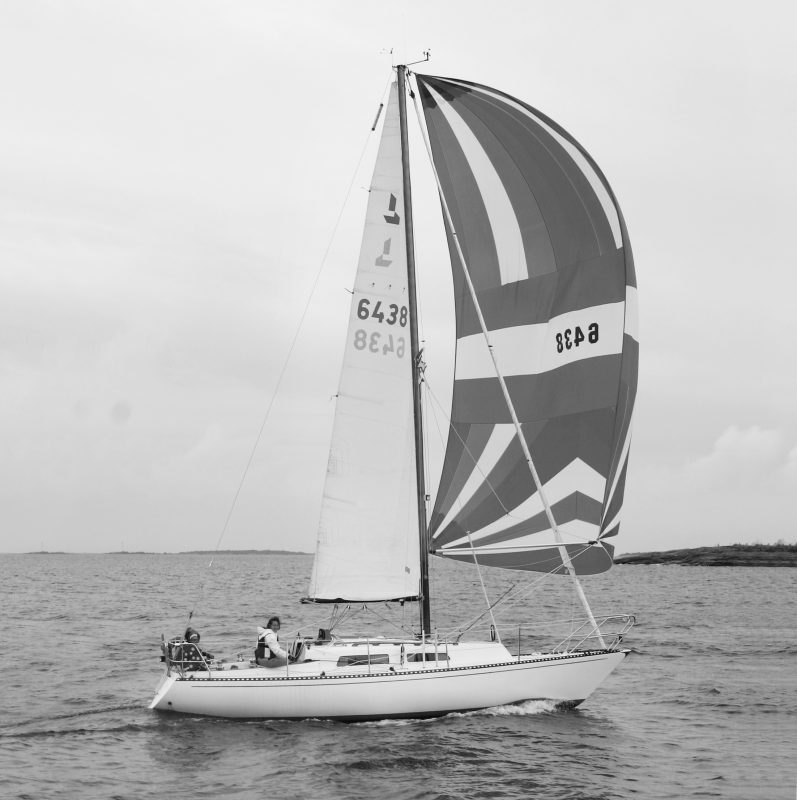
The First Linjett Model
The first Linjett – the Linjett 30 – left all its competitors in the dust. After nearly three years of developing and trialling their own boat in plastic, the designer and builder Jan Gustafsson (brother of Mats) won the Åland Sea Race in the Linjett 30, ahead of the Scampi which got second. Success had come, and the first 30 clients who had initially ordered the new Linjett 30 from the drawings, were thrilled with the result and their investment (even though they had to wait another year before they would receive their boats). In total there were 112 Linjett 30 boats built.
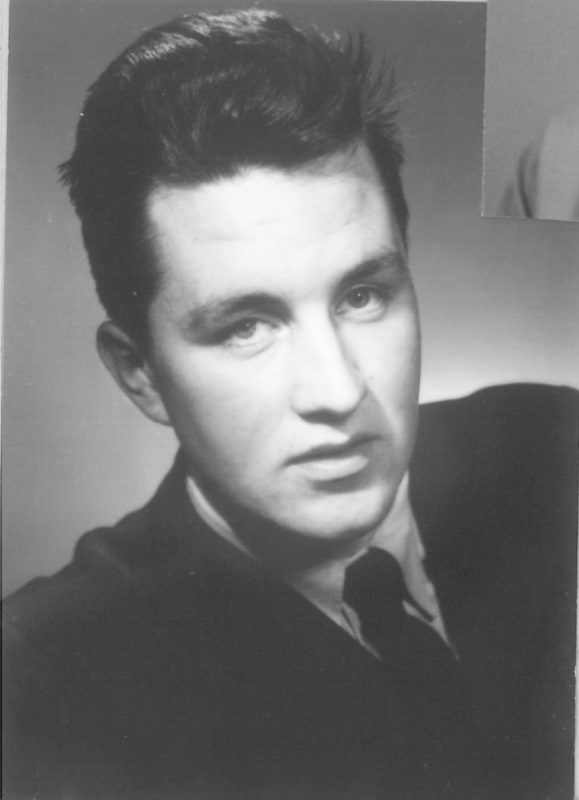
The Yard’s Own 30-footer
There was a lot of experimentation taking place with different boat models, and the boatyard was given more and more assignments to place interiors into plastic boats, like the OE 36 and Comfort 30. The idea of Rosättra making its own boat in plastic grew stronger, before Jan Gustafsson finally took the initiative and started designing a sailboat that was suitable for both cruising and racing. And so Rosättra’s first Linjett born: the Linjett 30.
The Gustafsson brothers bought together 30 sailing friends to introduce the idea of the Linjett 30, and it was enough that the family and Rosättra were behind the project to guarantee 30 orders for the Linjett 30. Financing was secured for the project against the drawings alone – however the question now was if the new yacht would be as good as the prototype? It was.
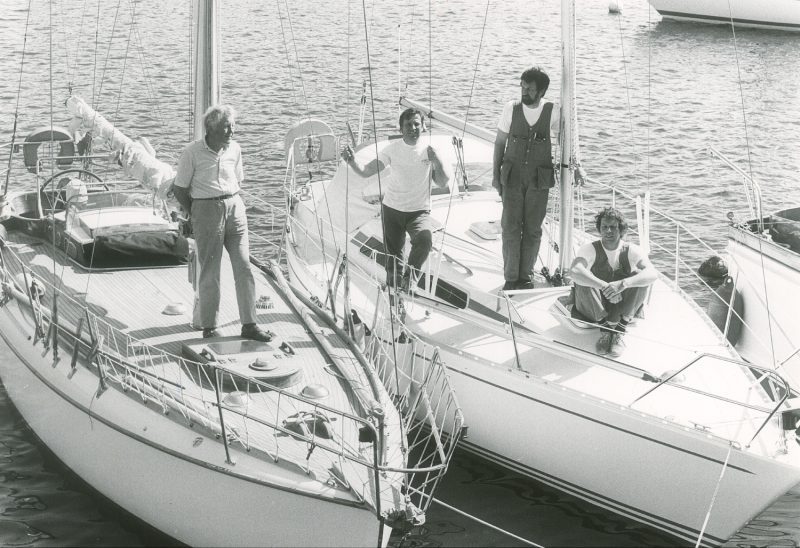
A New Era
Under the leadership of the second generation of Gustafssons – Mats, Jan and Ola – a revolution in boat building was taking place across the country. New line-production of plastic boats started to pop-up in the most unlikely places in the country. At Rosättra, the wooden boats were replaced with a new line-production of plastic boats. The era of wooden boats finished with the 70th Laurin Koster, launched in August 1969. The boatyard now began producing the new, affordable plastic boats.
Not many boatyards managed to change their sails to the new wind, and on the east coast of Sweden it was only the Rosättra Boatyard that succeeded in bringing together their history and knowledge of building wooden boats together with the modern era’s requirements for design and materials.
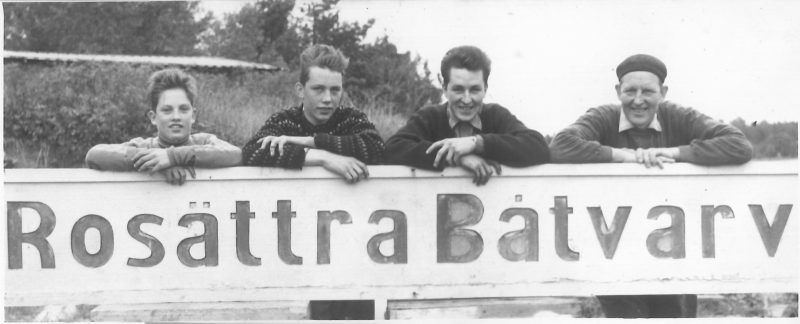
Corporation
Rosättra Boatyard becomes a Corporation and two of Fritjof’s sons, Jan and Ola became part owners. A few years later Fritjof became ill with Asian Flu, so in 1967 his sons took over the whole management for the yard until he was back on his feet a few years later.
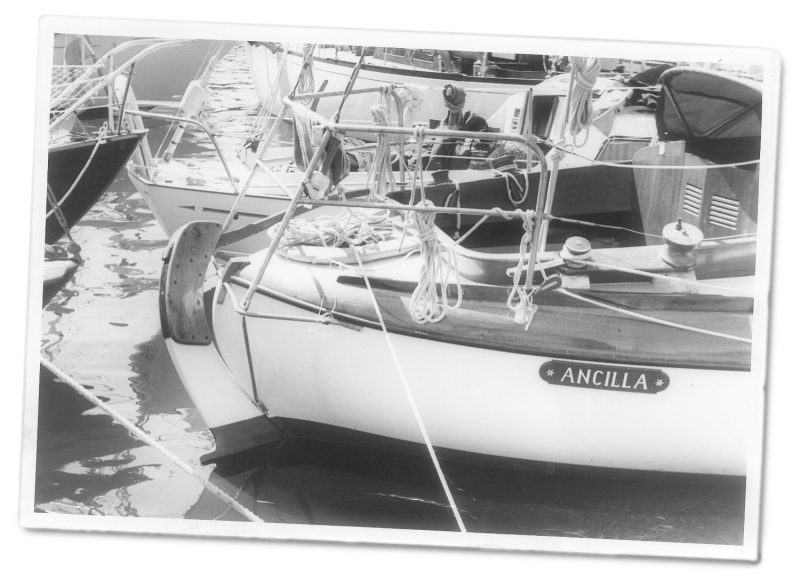
The Second Generation Gustafsson
At the end of the 50s, the future and direction of the boatyard began to shape when the Gustafsson brothers Jan, Ola and Mats all started sail racing: Jan built his own 5.5 dinghy and qualified for the Olympics while Mats was also highly successful.
They went one step further in the early 1960s, when the brothers made their entry into boatbuilding world by producing a Laurin Koster each. Ola’s was Soniola and the Koster Andrina was built by Jan, Mats named his Koster Ancilla (which all his boats later came to be called).
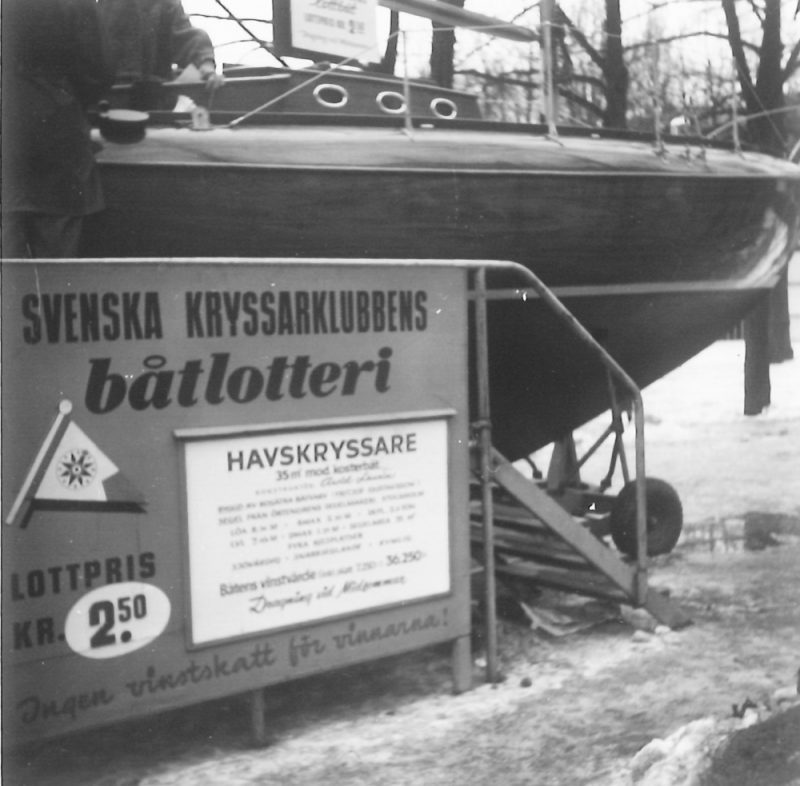
The Lottery Boat
“The Lottery Boats” became a well-loved and successful tradition in Sweden from early spring to Midsummer, allowing anyone to buy a ticket and potentially win a boat.
It was a fantastic marketing opportunity for the Rosättra Boatyard, and during the 1950s the yard built three Laurin Kosters for the Lottery, meaning there was never a shortage of work during this time. The Lottery Boat played an important role for the success of many of the smaller yards – to have a boat in the lottery allowed new yacht designers a spotlight and breakthrough for their career and reputation.
In this picture is a Laurin Koster built by Fritjof Gustafsson in 1960.
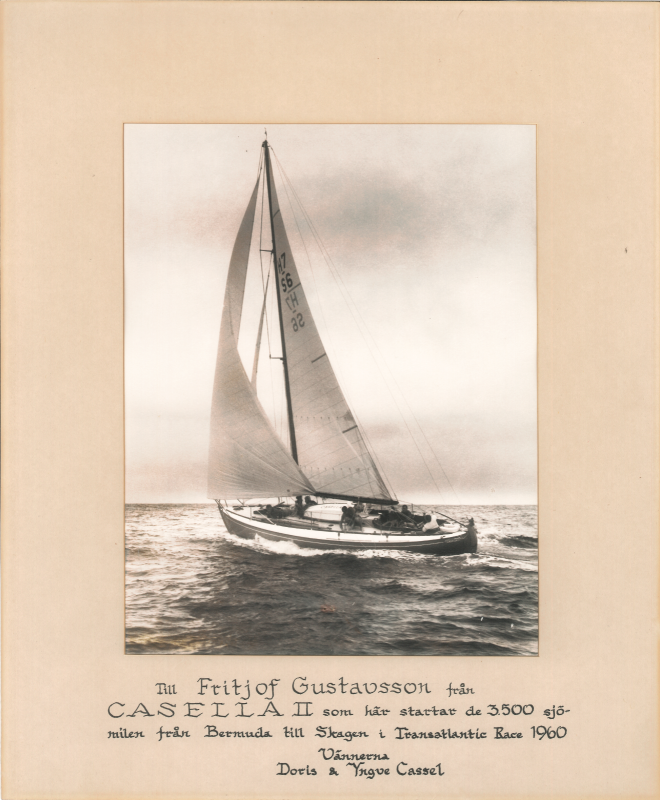
Casella II Sails Transatlantic
The first Laurin Koster was built by Fritjof Gustafsson for Yngve Cassel and was named Casella I. It was 10.25m long, 2.65m wide and weighed six tons, built completely in mahogany and sailed across the Atlantic to the Caribbean in 1956.
Casella I was followed by Staika III and Spica before the famous Laurin Koster Casella II was built.
The boat became famous in 1960 when she took part in the Transatlantic Race, which to this day is still one of the world’s longest races covering over 3,500nm between Bermuda and Skagen. Onboard the Casella II was, of course, Rosättra’s then owner and boatbuilder, Fritjof Gustafsson.
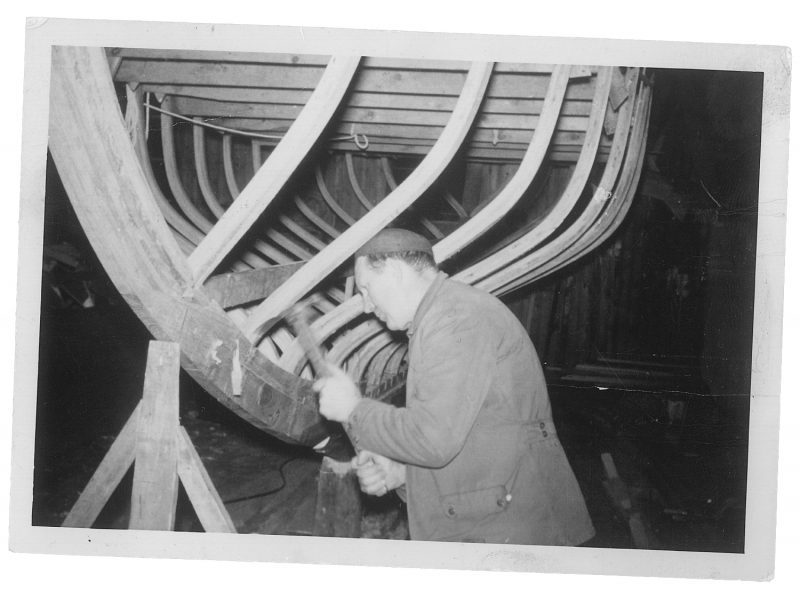
The Laurin Kosters
When the Laurin Kosters started being built at Rosättra, the boatyard began a new and golden era.
These boats where “strong as tanks and agile as panthers” and almost all of them were built by Rosättra. The most famous Laurin Koster is “Casella II,” which sailed in the Transatlantic Race in 1960 and took victory in the largest offshore race in Sweden, the Around Gotland Race (Gotland Runt) in 1959.
The Laurin Kosters were expensive boats to build, so here is where the idea came for building semi-finished boats, allowing buyers to do the last works on their own.
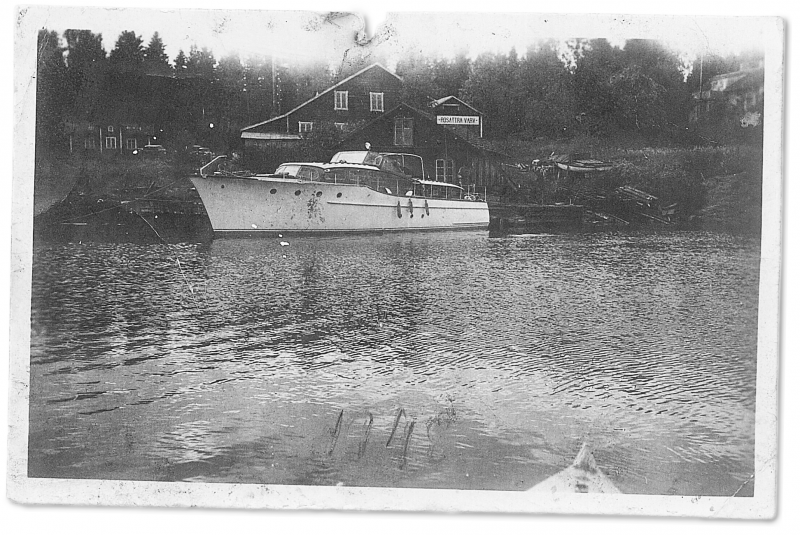
The Motor Yacht
In the winter of 1950–1951, this motor yacht was built for Mr Wahrens in Norrköping.
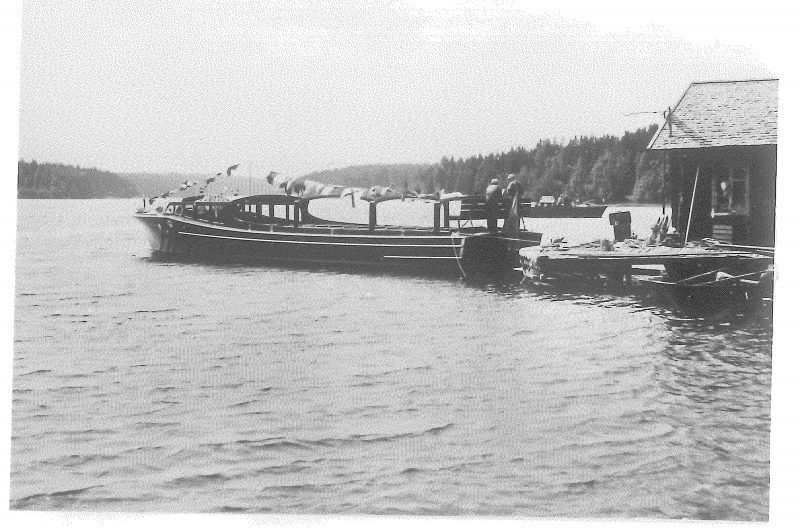
Queen Mary
After Fritjof bought the boatyard, Rosättra received its largest order to date that not only came with good money but also prestige.
The Stockholmer Bertil Sjöberg operated a company with tourist boats and expanded his fleet with a new sightseeing boat, the Queen Mary which was 18m long and four meters wide. Built at Rosättra, the Queen Mary is still sailing with tourists in Stockholm today – an example of how the quality of our boats stands the test of time.
With the arrival of the Korean War in 1950, Fritjof also turned the yard over to making church benches with the help of his sons Ola, Jan and Mats. And when the war was over in 1953, the winds turned for the better.
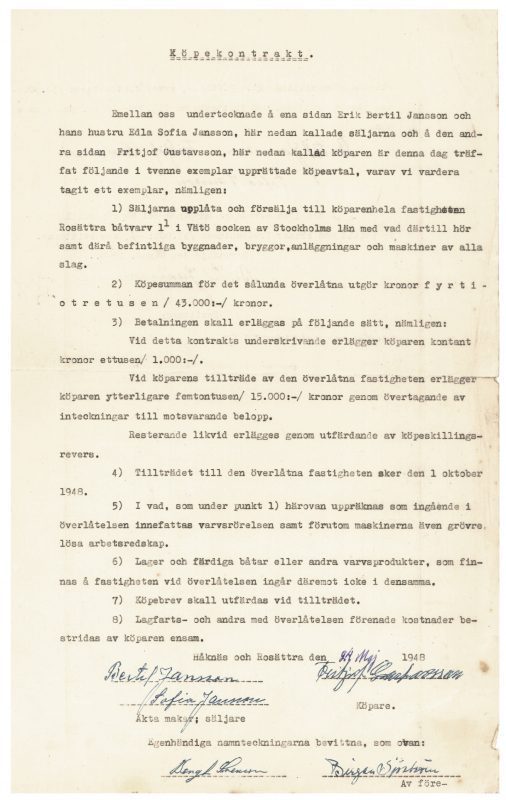
The Gustafsson Family Takes Over
Bertil Jansson had no children, so when he wanted to retire at age 60 there was no successor.
For many years Fritjof Gustafsson had worked on and off at Rosättra, so when Bertil called Fritjof to see if he would buy the yard, Fritjof knew it had a great reputation and was well-equipped. He also understood the ongoing struggle of managing orders in the autumn and getting them ready for delivery by spring. Despite the challenges, Fritjof agreed to buy the yard.
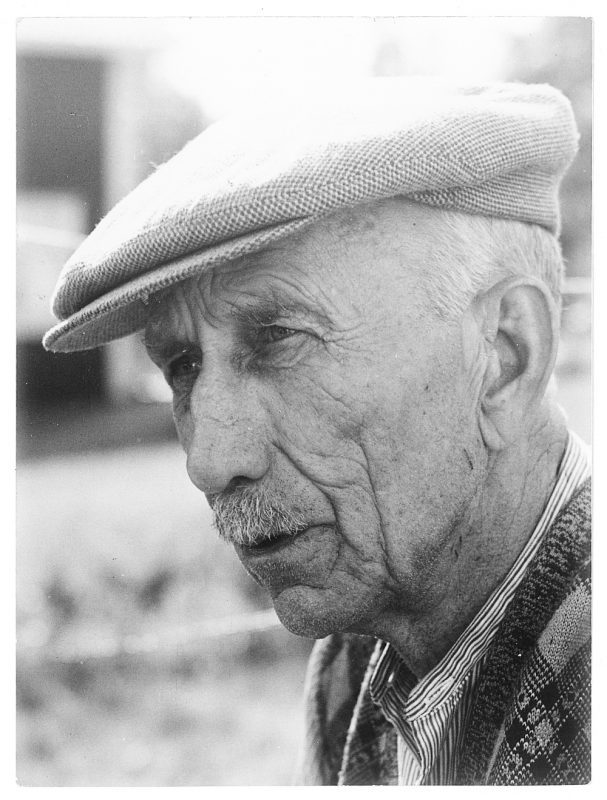
Bertil Jansson
Bertil Jansson paid SEK 17,200 to buy the yard from his father Erik and became the sole owner. Tough and harsh, Bertil was very orderly and always kept the yard neat. He was not a man to argue with and many assumed he inherited this attitude from his father Erik, who before he sold the yard to his son, revealed he thought it a shame to pay as much as SEK5.20 for a few hours of boatbuilding.
During Jansson’s time at the yard, Rosättra collaborated with the most prominent yacht designers of the time, including Knud H Reimers, Jac M Iversen, C G Pettersson, Tore Holm and Gustaf Estlander.
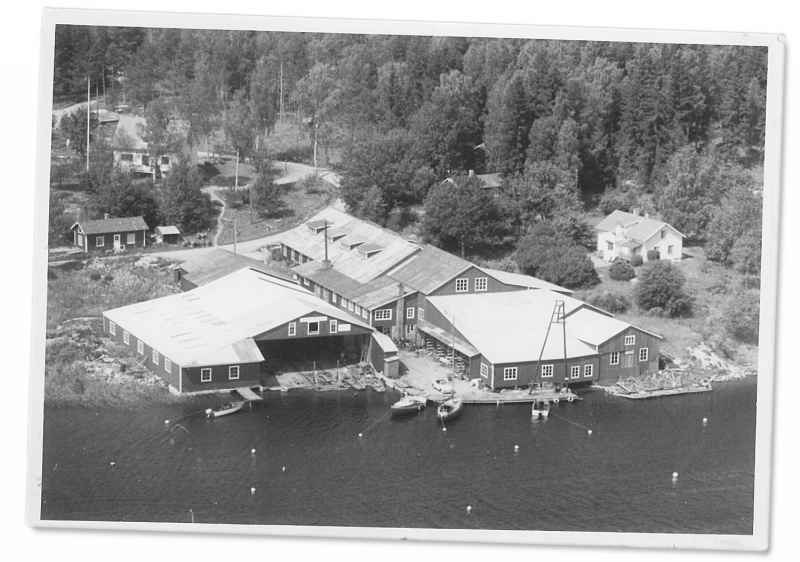
The New Hall
The new production hall was launched by Swedish MP, Per-Albin Hansson who came all the way from Stockholm for the occasion. At the time, the boatyard had a good order book and was profitable, but the two brothers Bertil and John did not get along, so it was decided that the brother with the most sons would buy out the other. This meant John continued with another company, Rosättra New Workshop, which later went bankrupt.
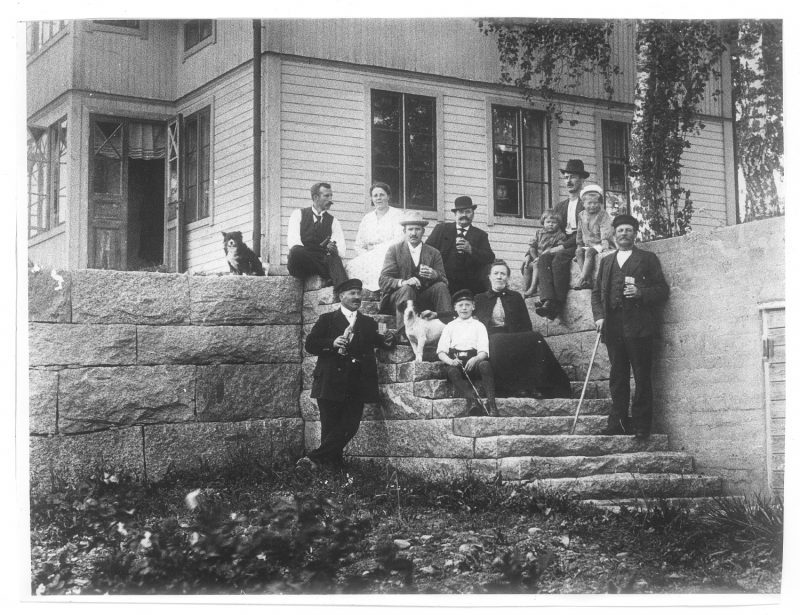
The Jansson Family
In 1914, Erik Jansson handed over the yard to his sons Bertil and John, who went on to make one of the yard’s biggest improvements in 1916 with the building of a new production hall. It was the largest investment made since the start of the yard and was based on orders continuing to come in.
In 1916, the company Pythagoras located in Norrtälje ordered a 16m long motor yacht with a new two-cylinder engine of 30hp.
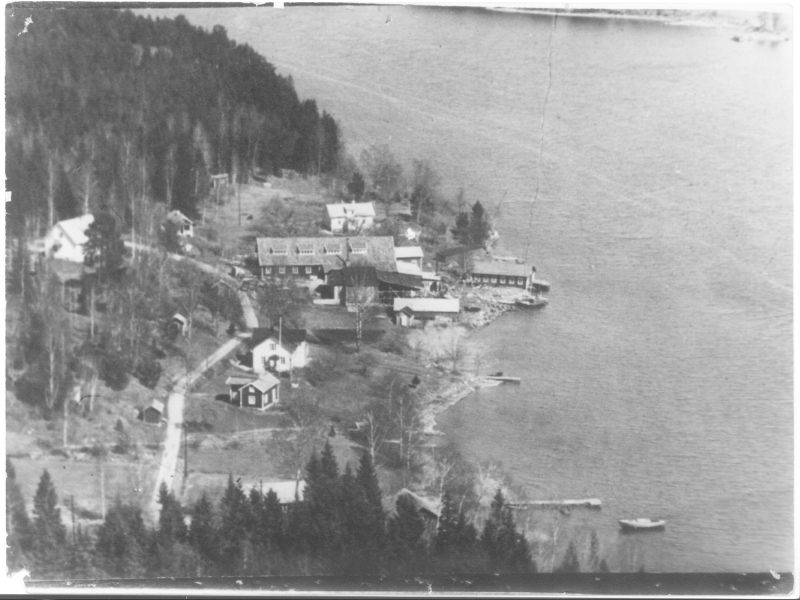
NK Orders Boats
1906 was a notable year when LM Ericsson ordered three 8.5m powerboats in oak. The same year NK (Nordiska Kompaniet) in Stockholm started ordering sailboats from Rosättra. In total, there was a production of about 50 day cruisers that all were delivered to Stockholm by the Vaxholm Ferry Yacht.
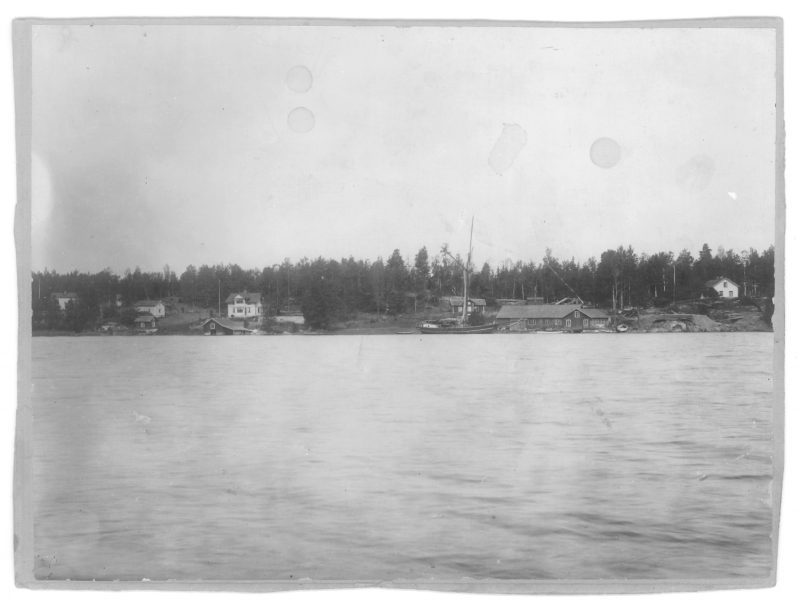
Unemployment Was the Start
When the Bogesund’s boatyard was closed down, boatbuilder Erik Jansson decided to start his own yard and found a site at the Rosättra Farm located on the island of Vätö, a few miles north of Norrtälje. Erik had an idea of building smaller boats. Not only because they required less resources, but he realised people had started sailing for pleasure and the need for private boats was on the horizon.
In fact, the period just before the turn of this century is one of the most exciting times in the history of Swedish sailing. In the 1890s when Oscar II was king, entertainment and race sailing was in full swing, and many of Sweden’s major sailing associations were formed during these years.
Erik Jansson’s idea came at the right time and the boatyard was successful and he ran it for the first few years with his brother Matts. Annual sales rose from SEK 3,000 to SEK 12,000 in the ten years it launched, with ten employees earning about SEK 5 per day, which at the time was considered well paid.